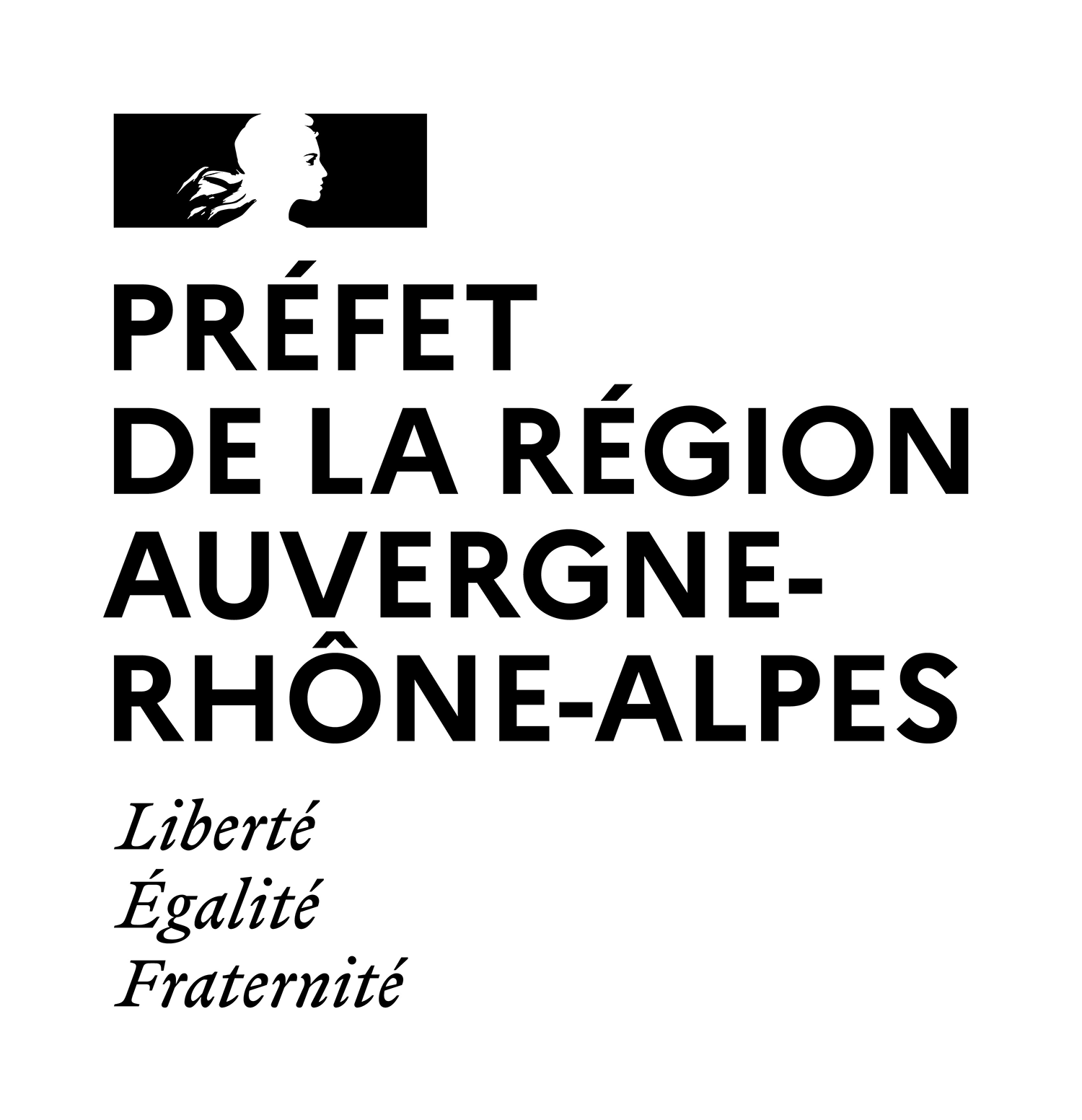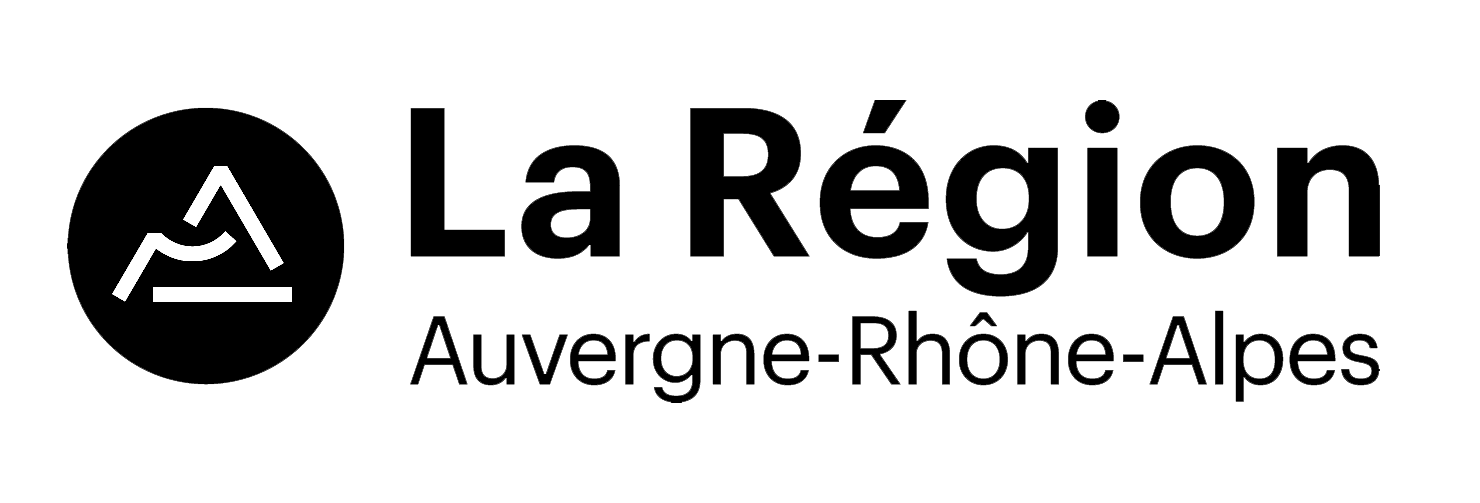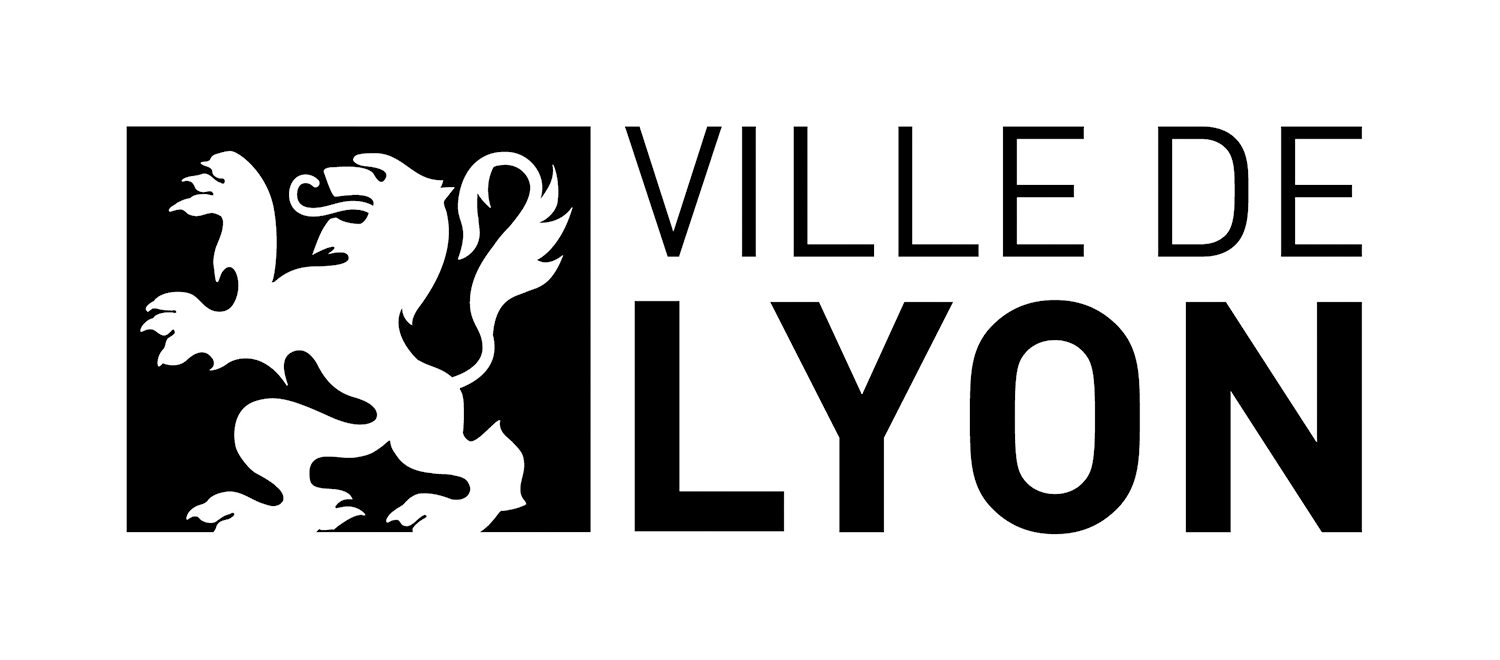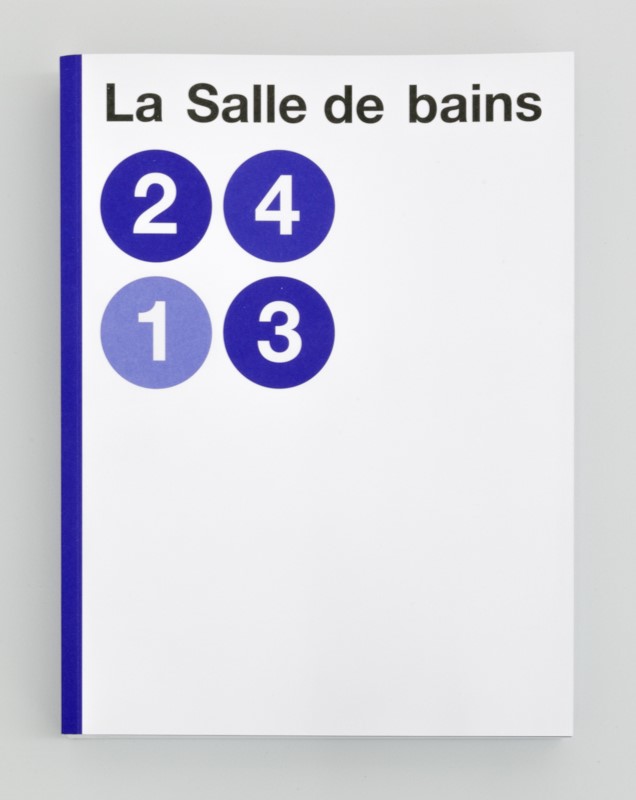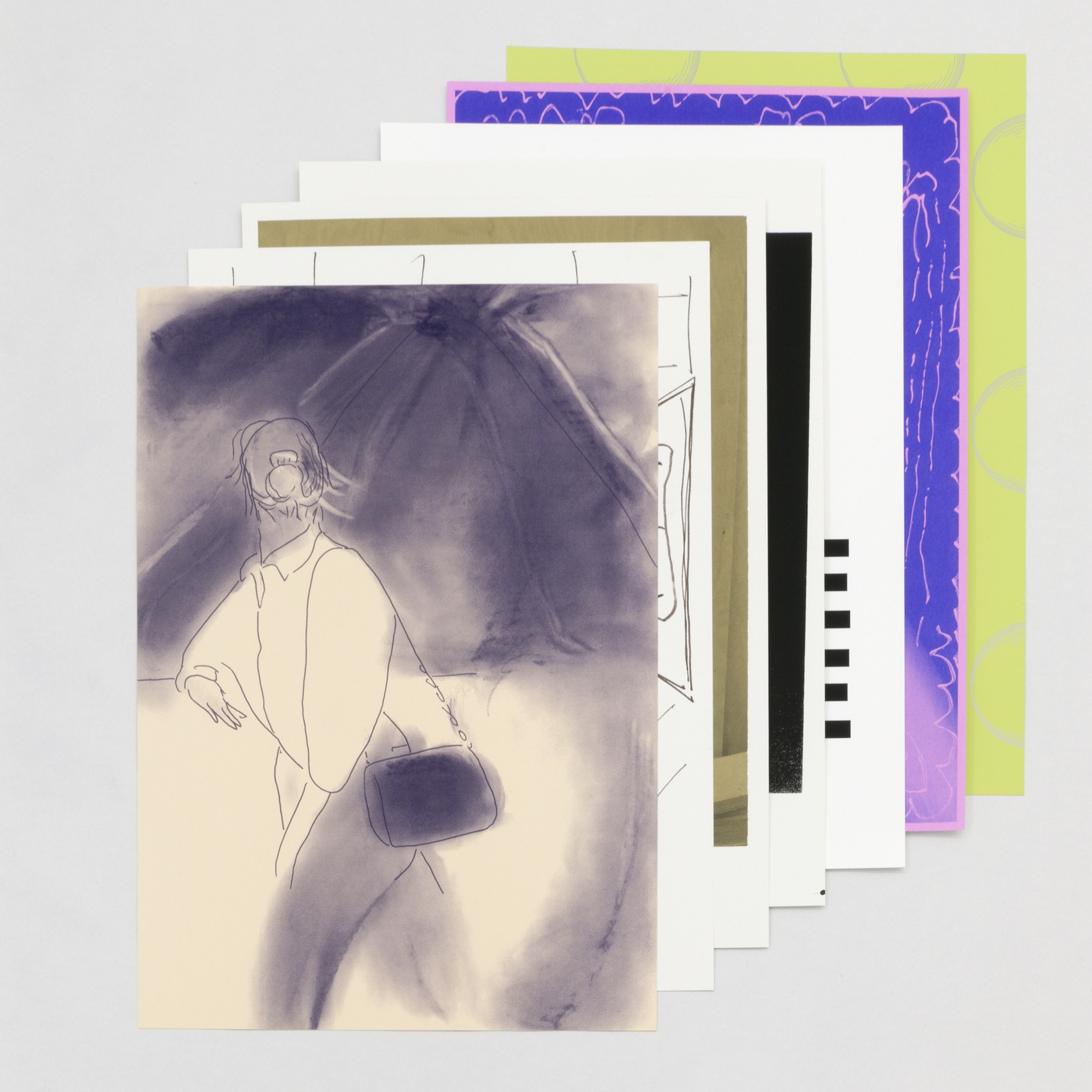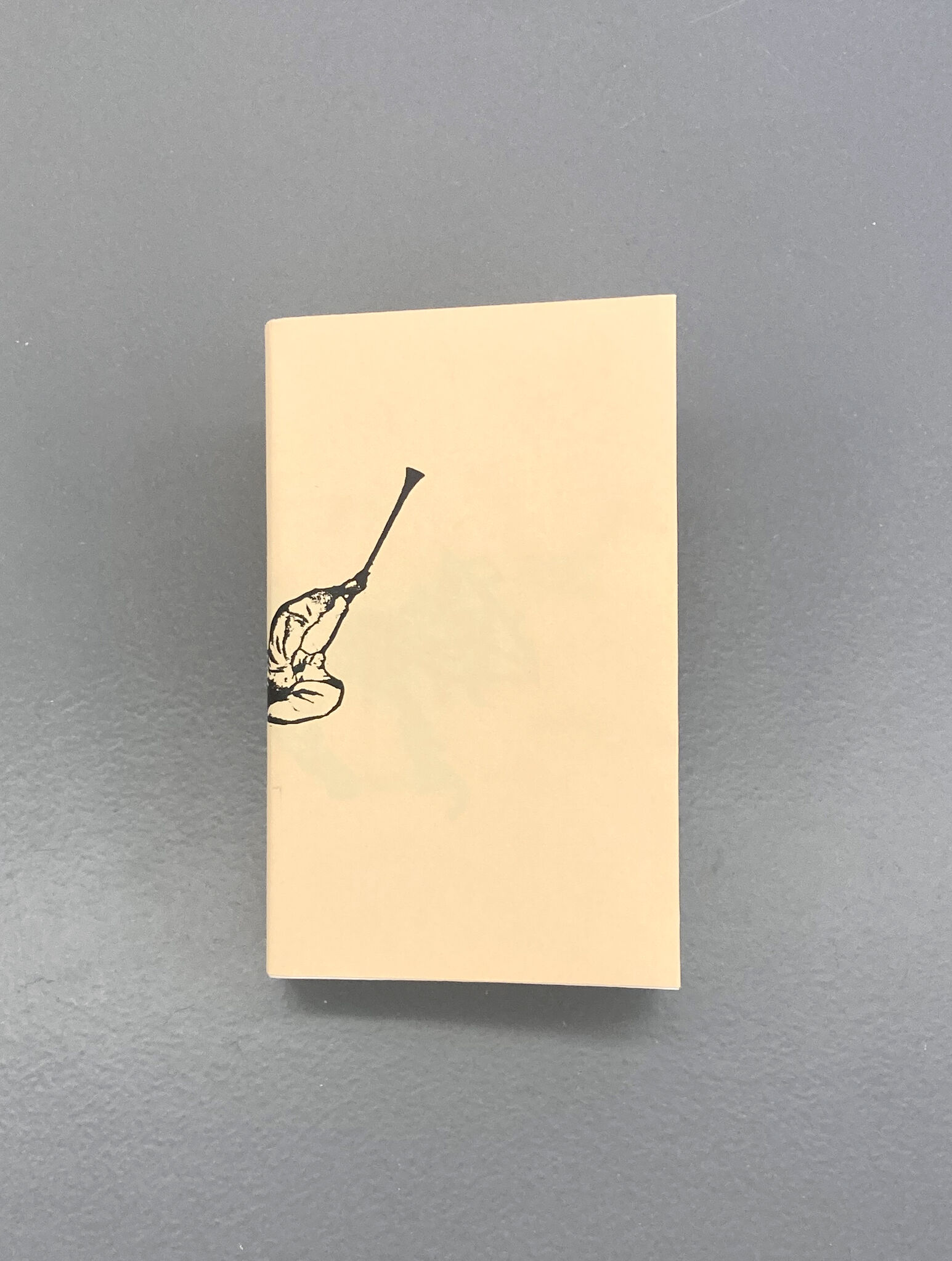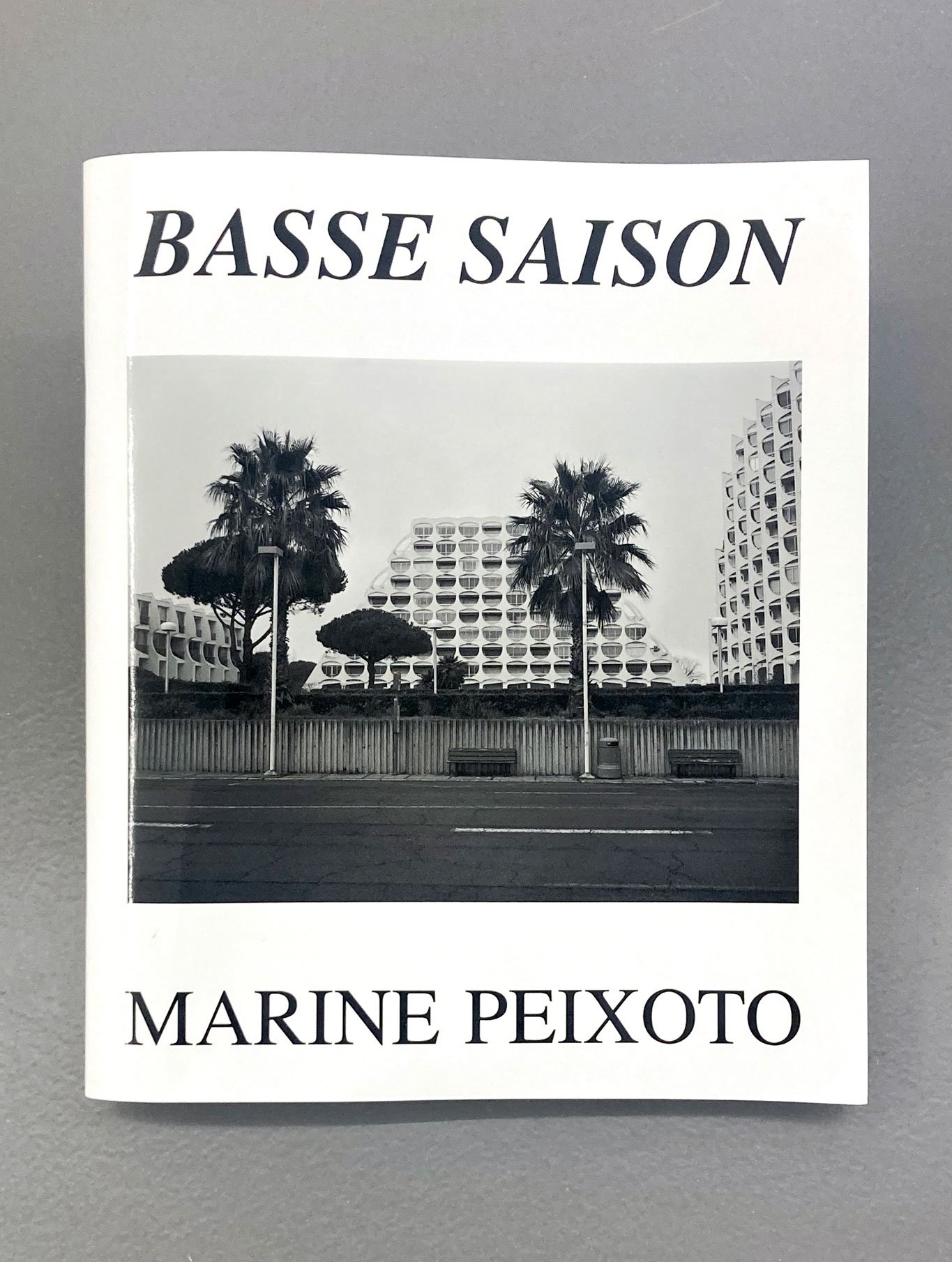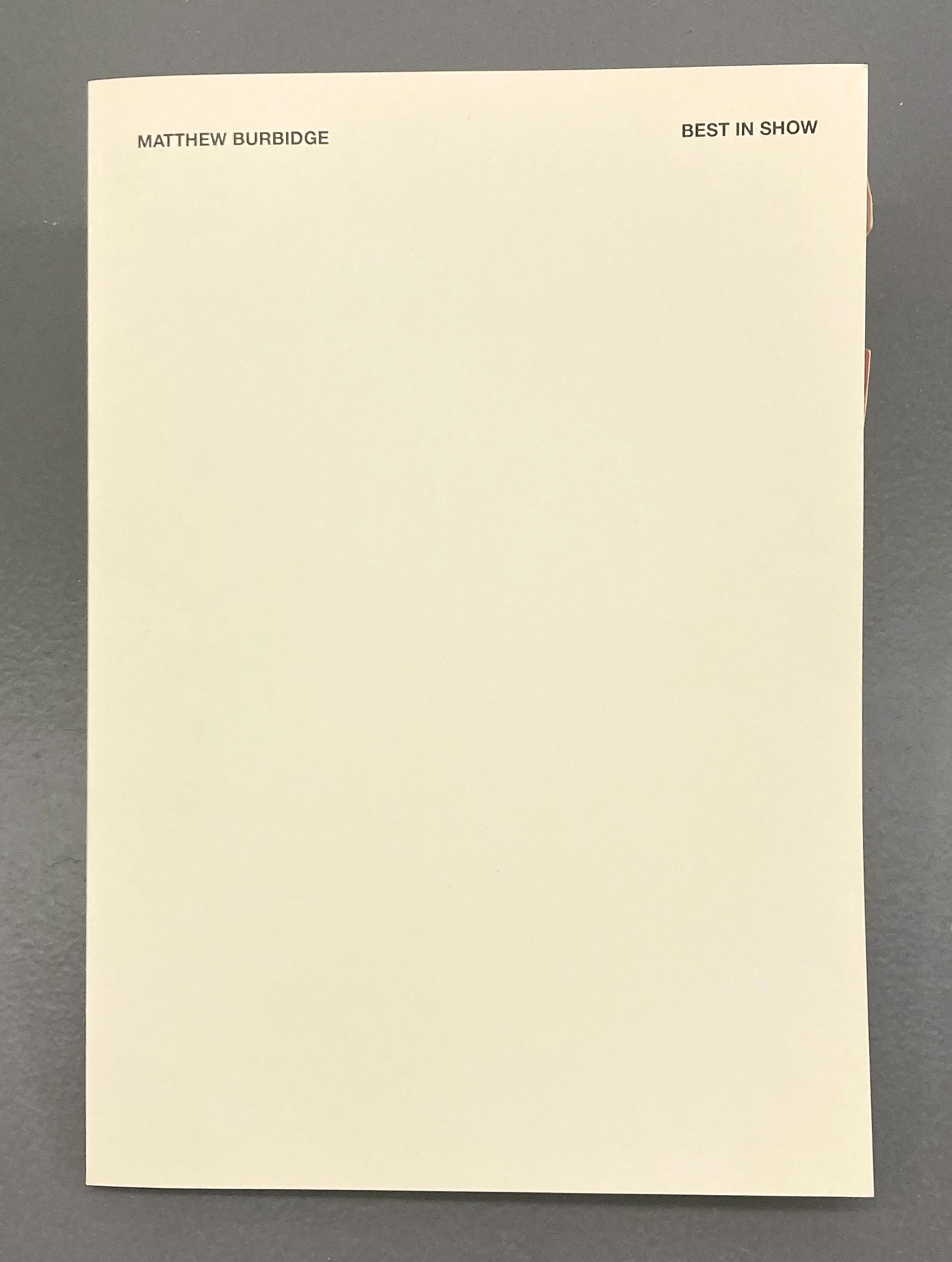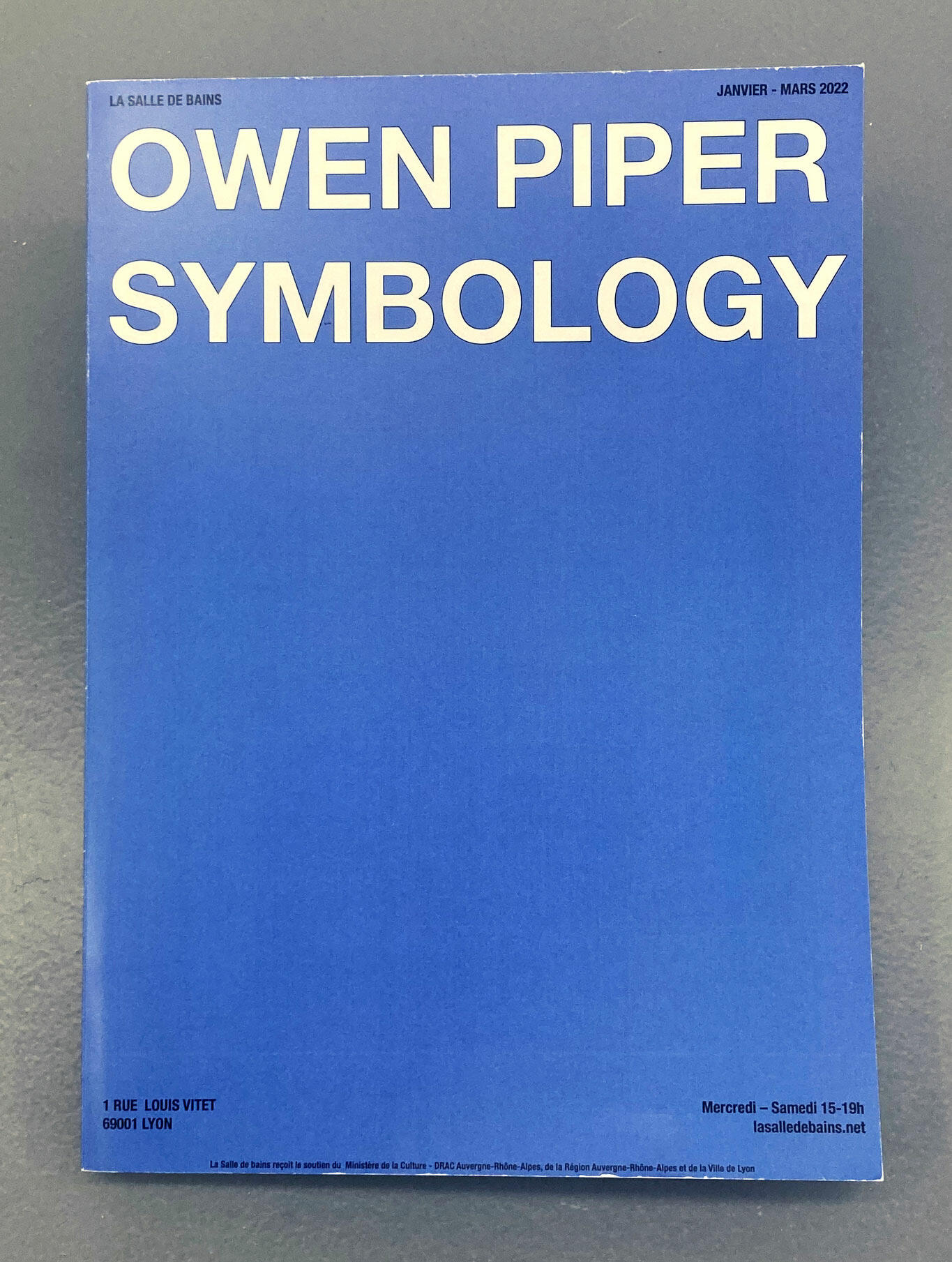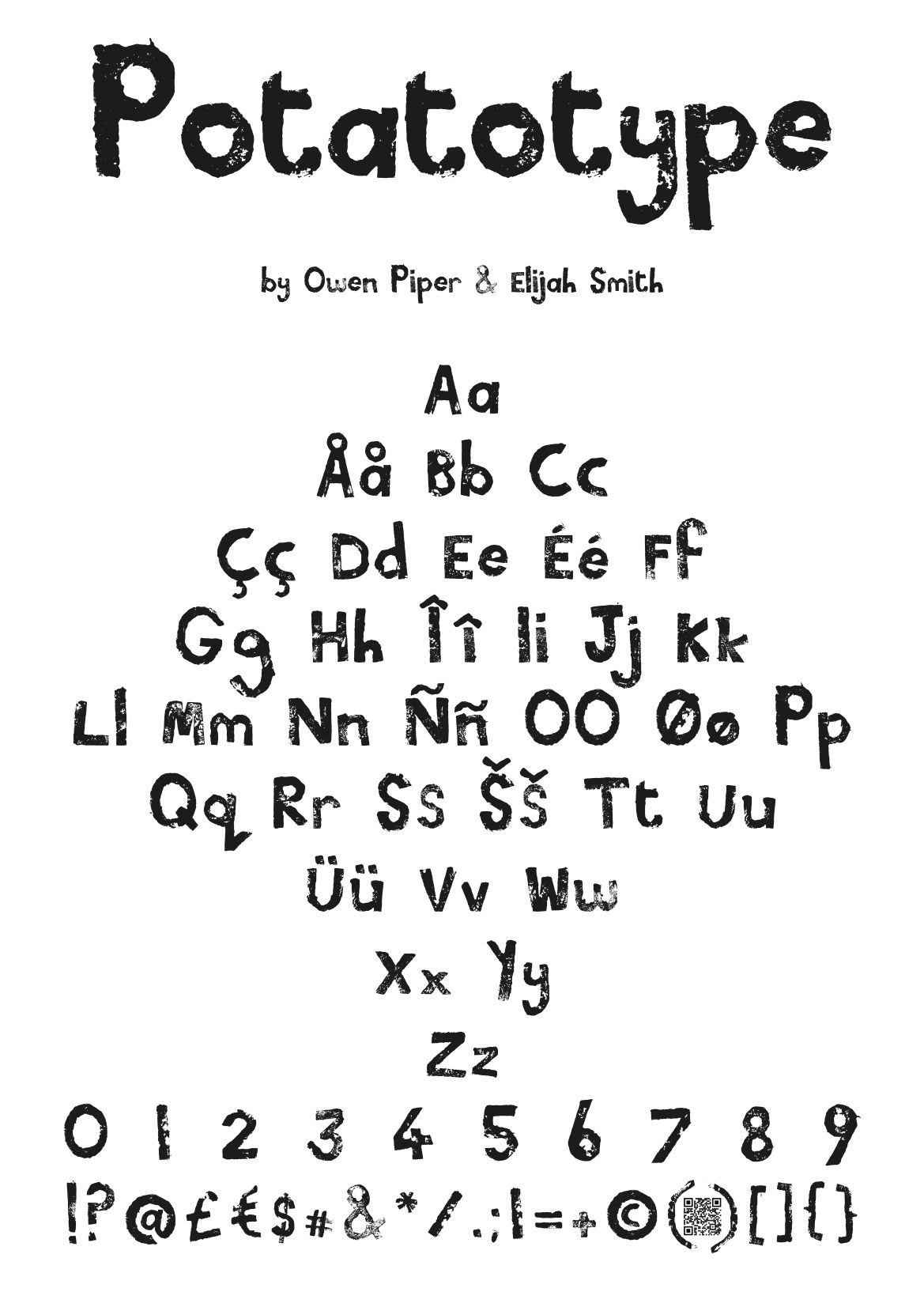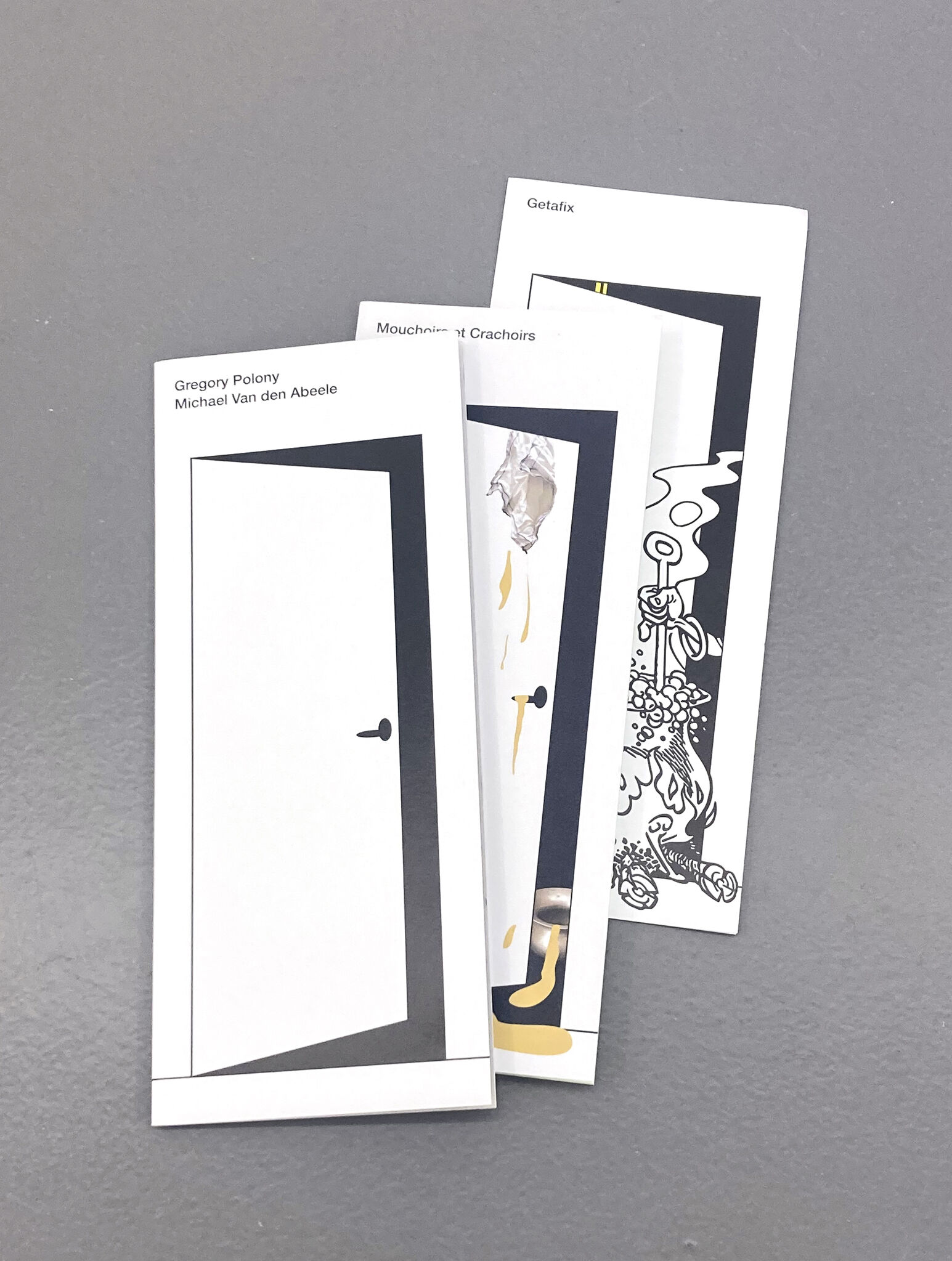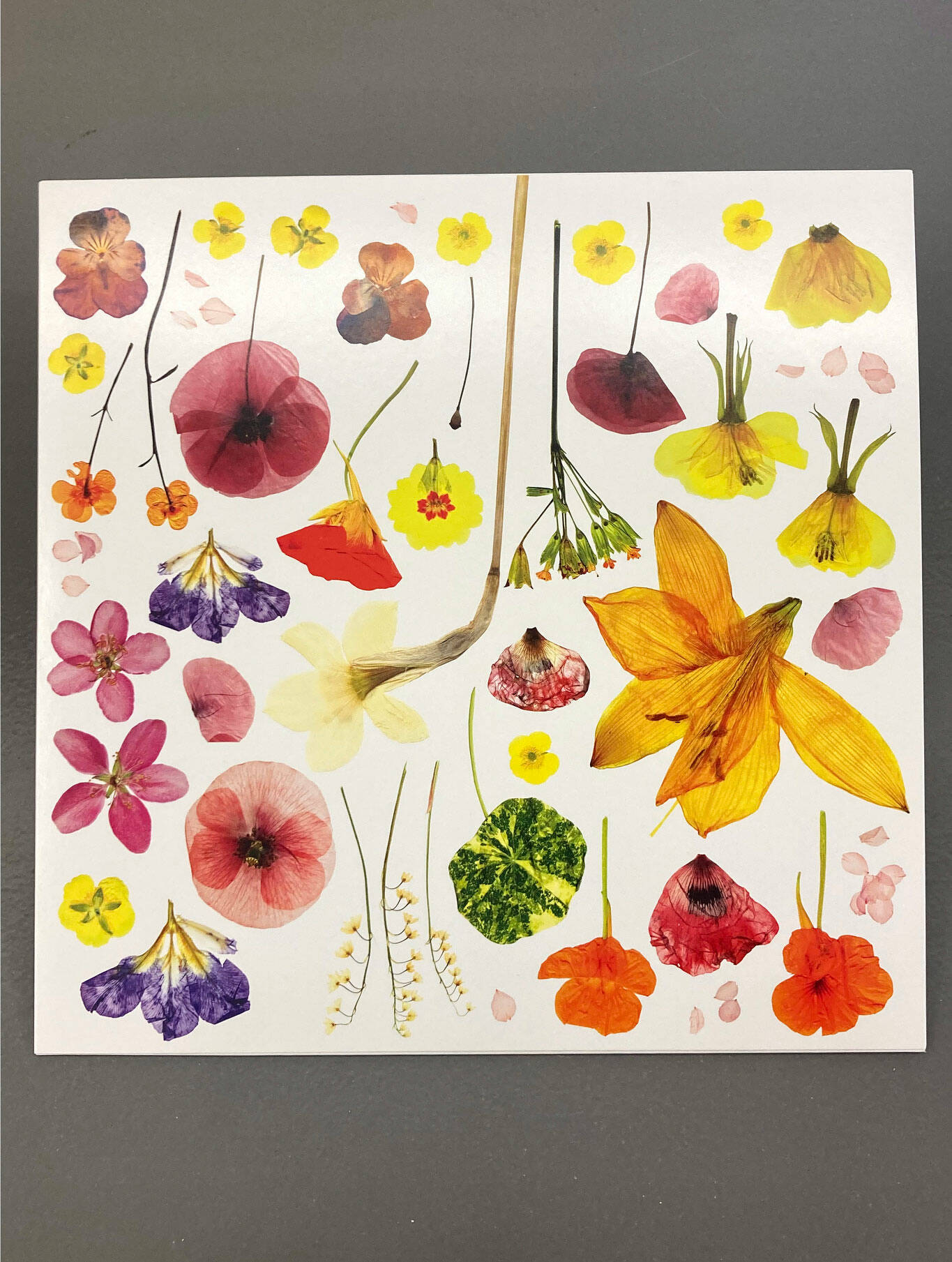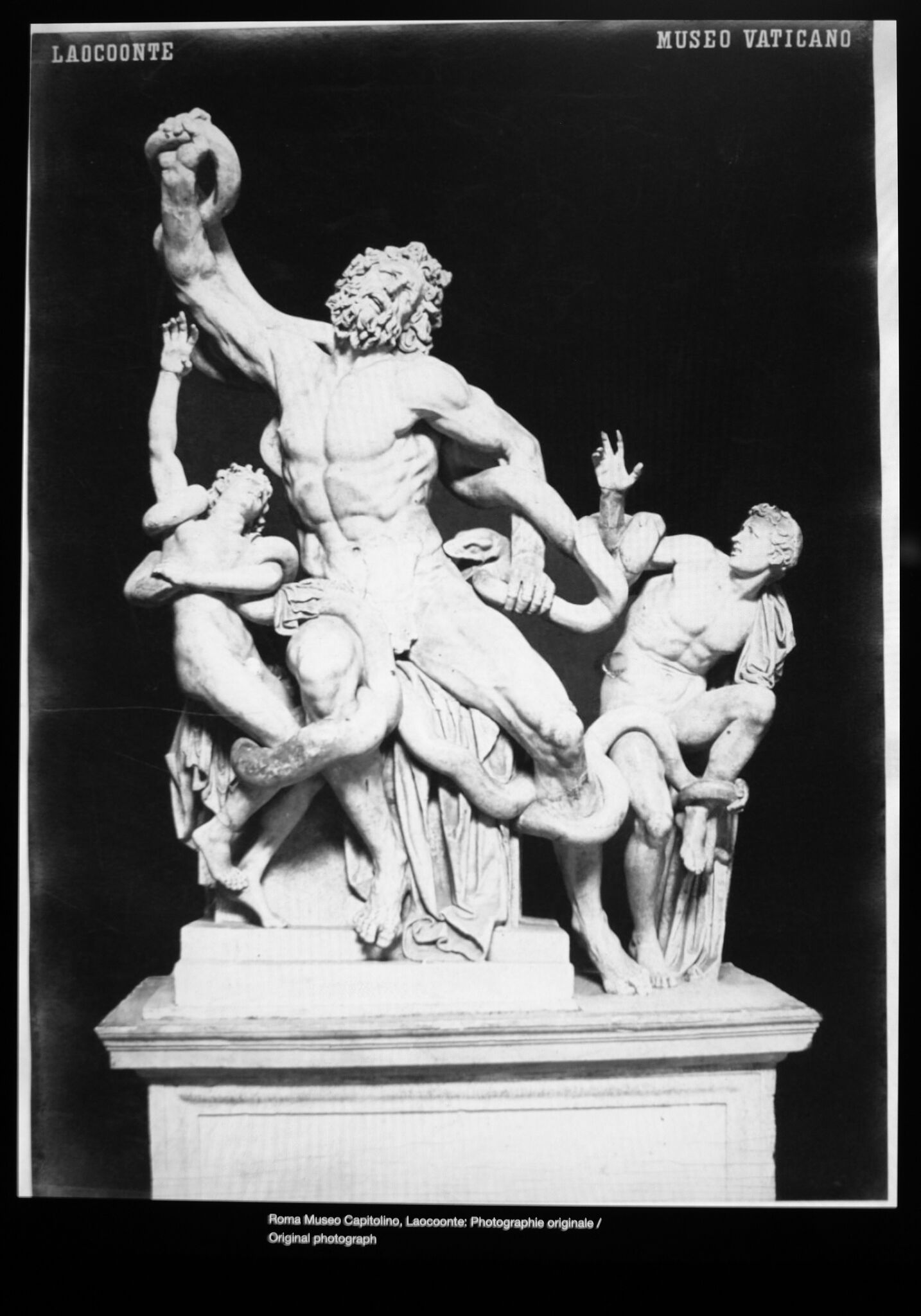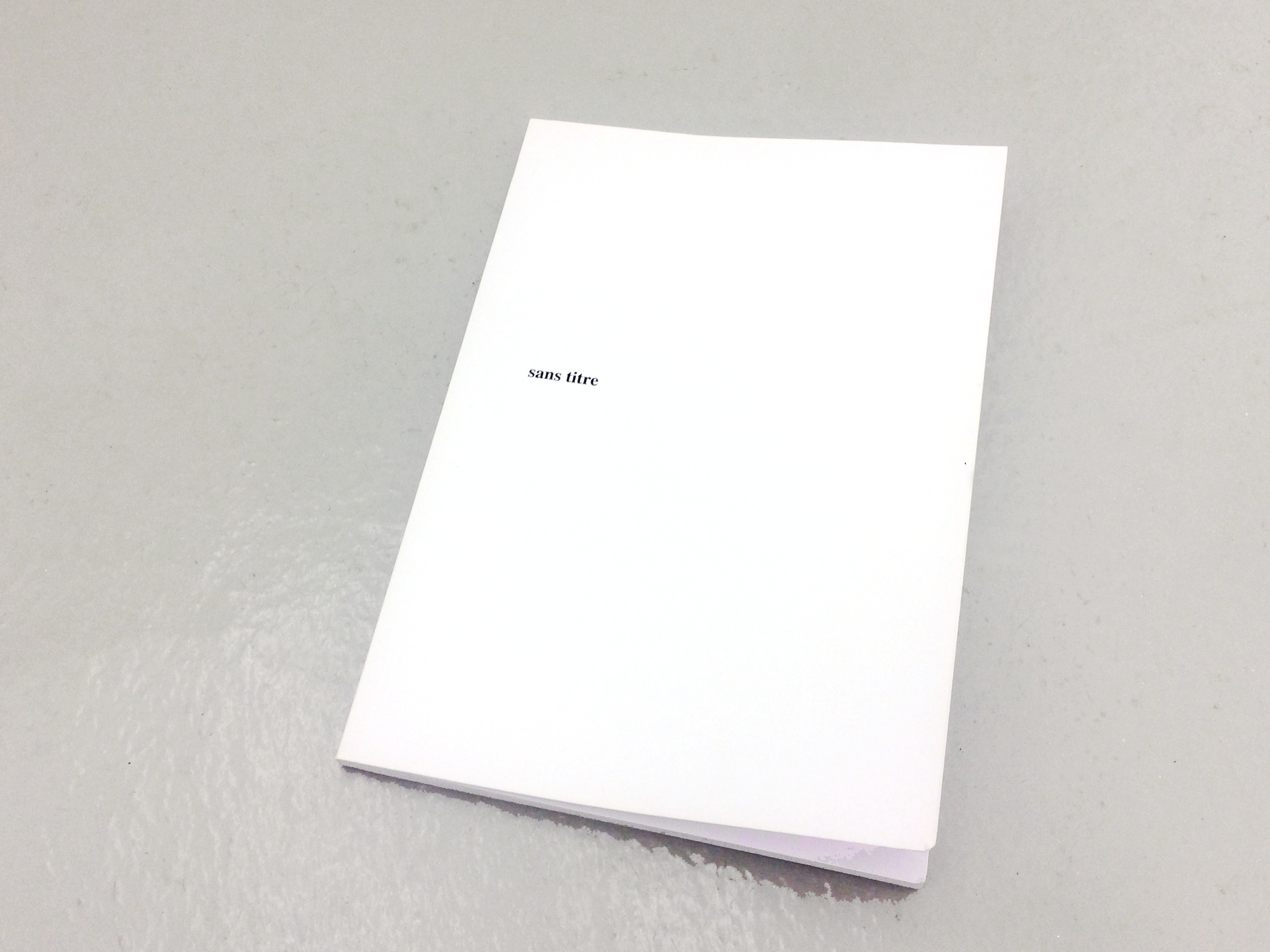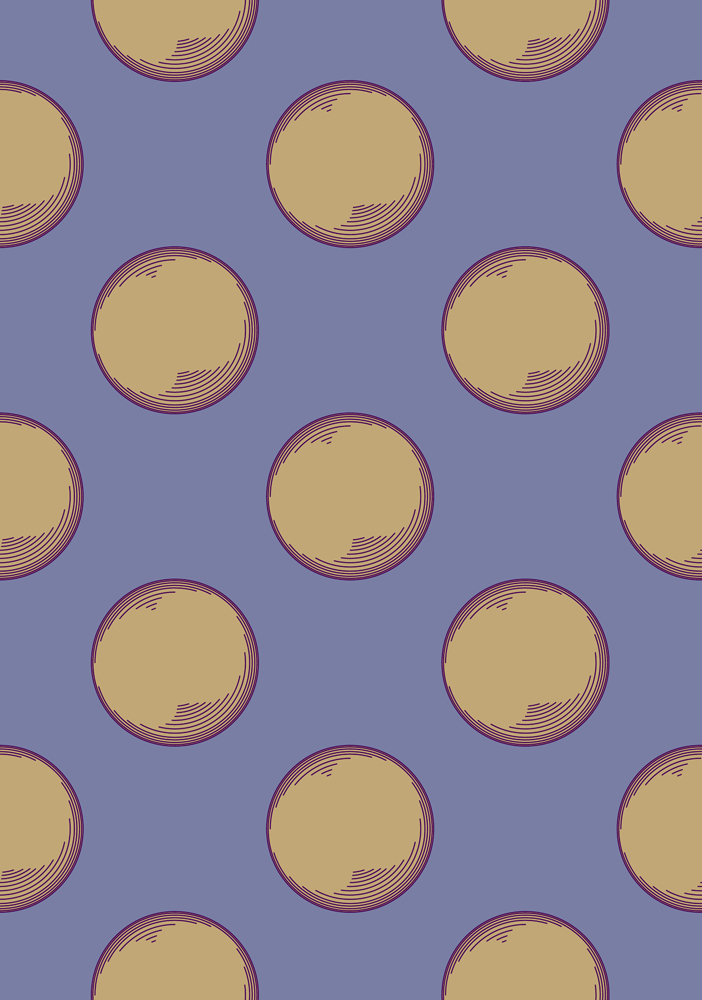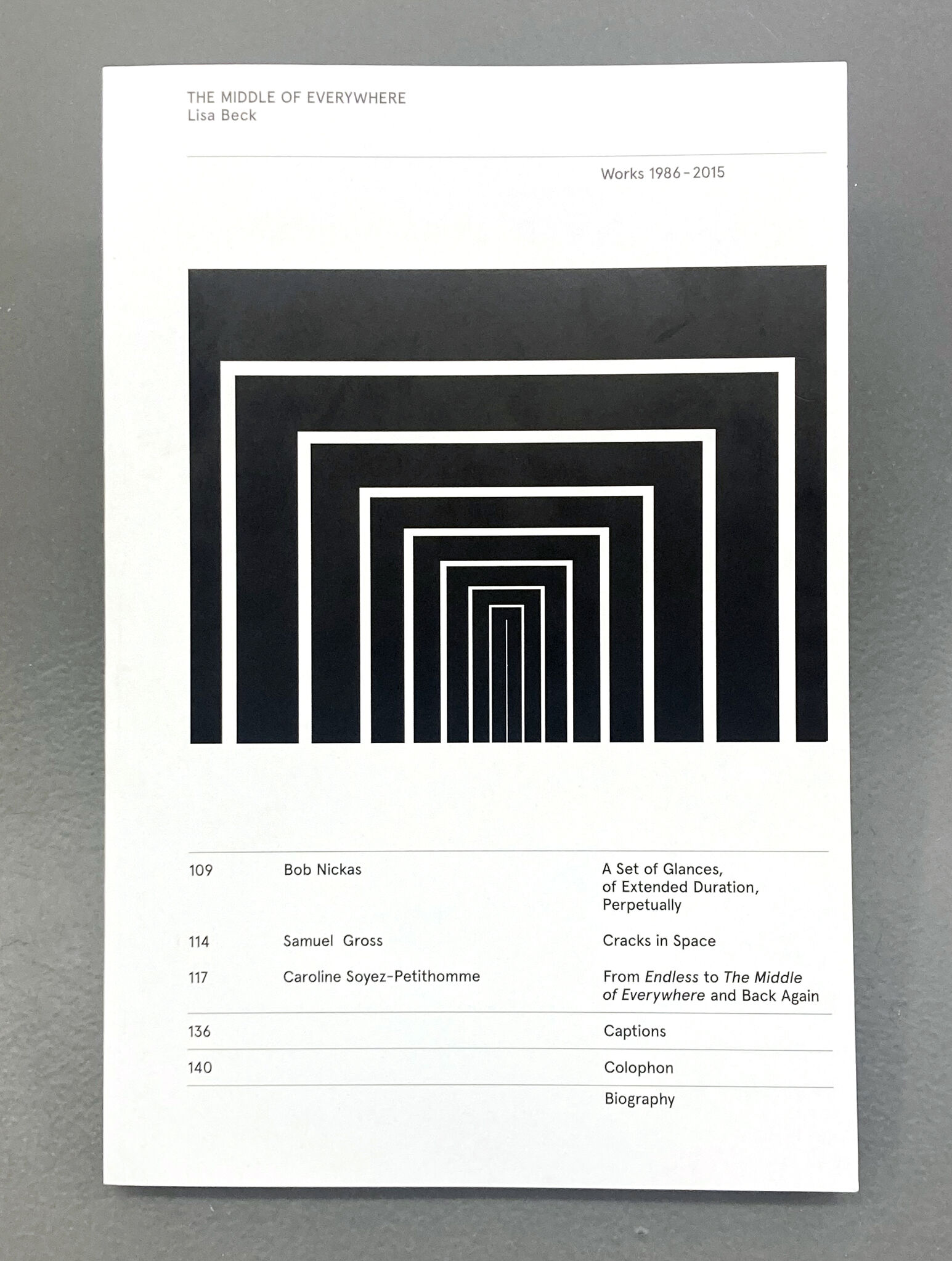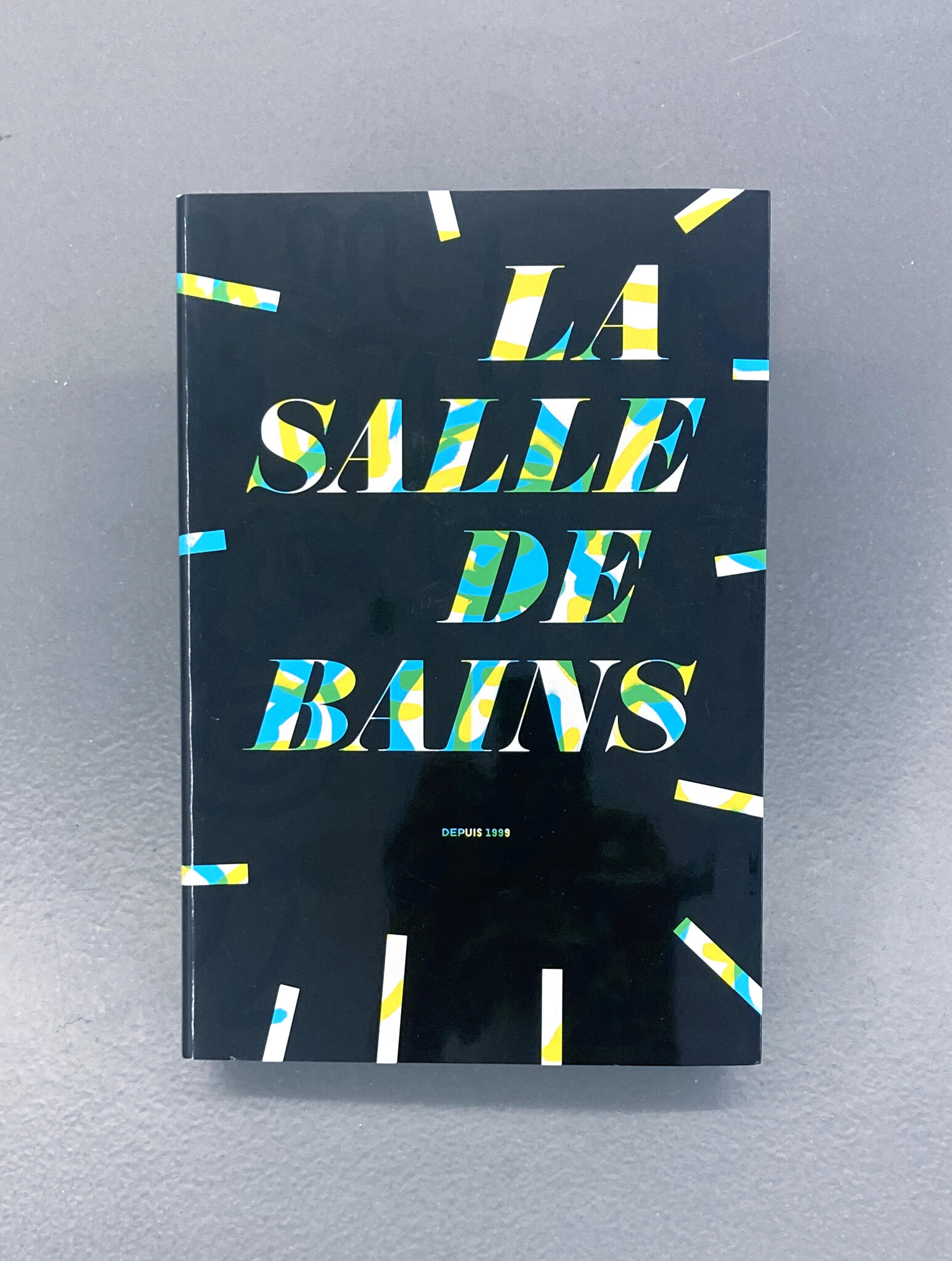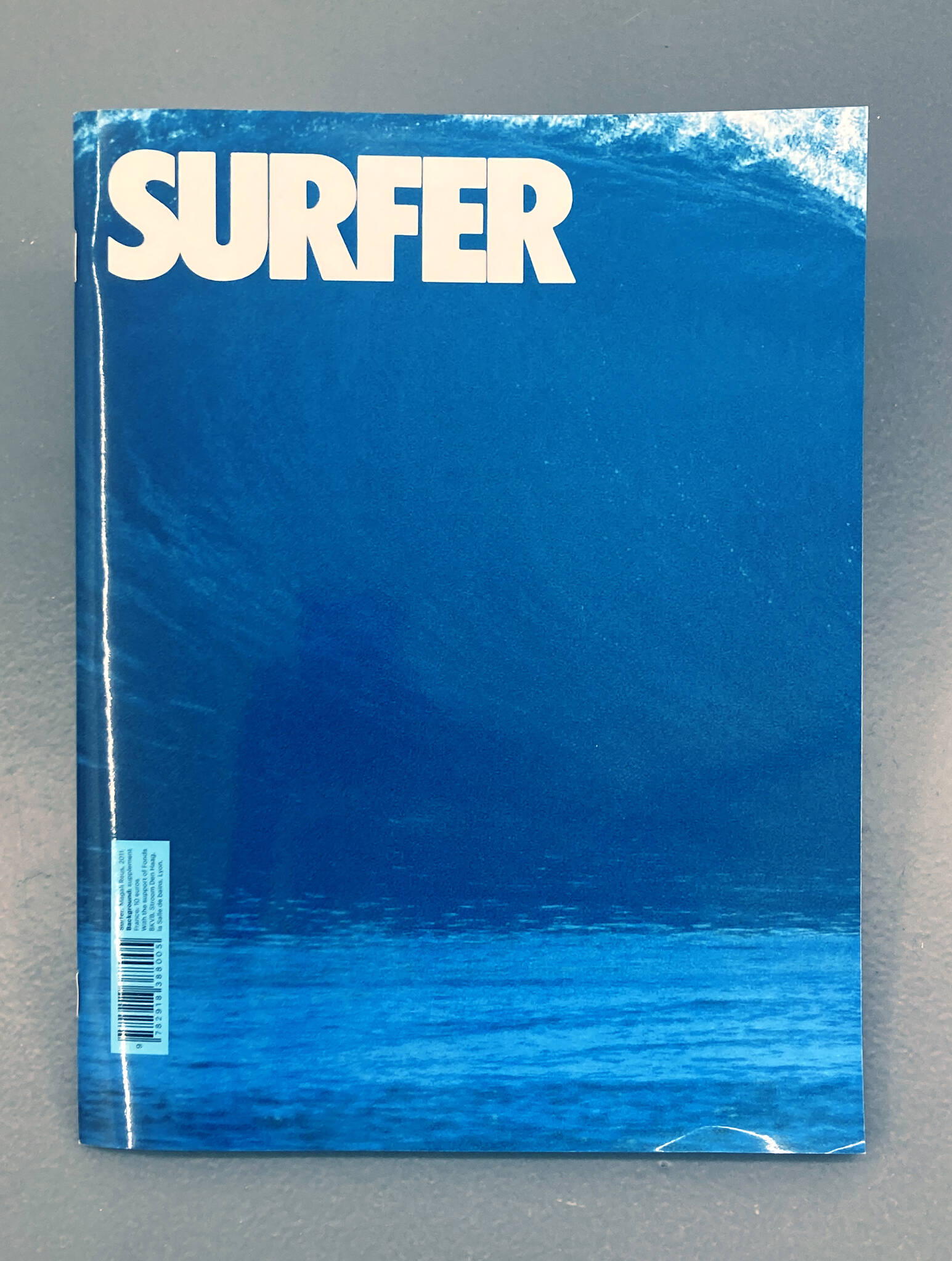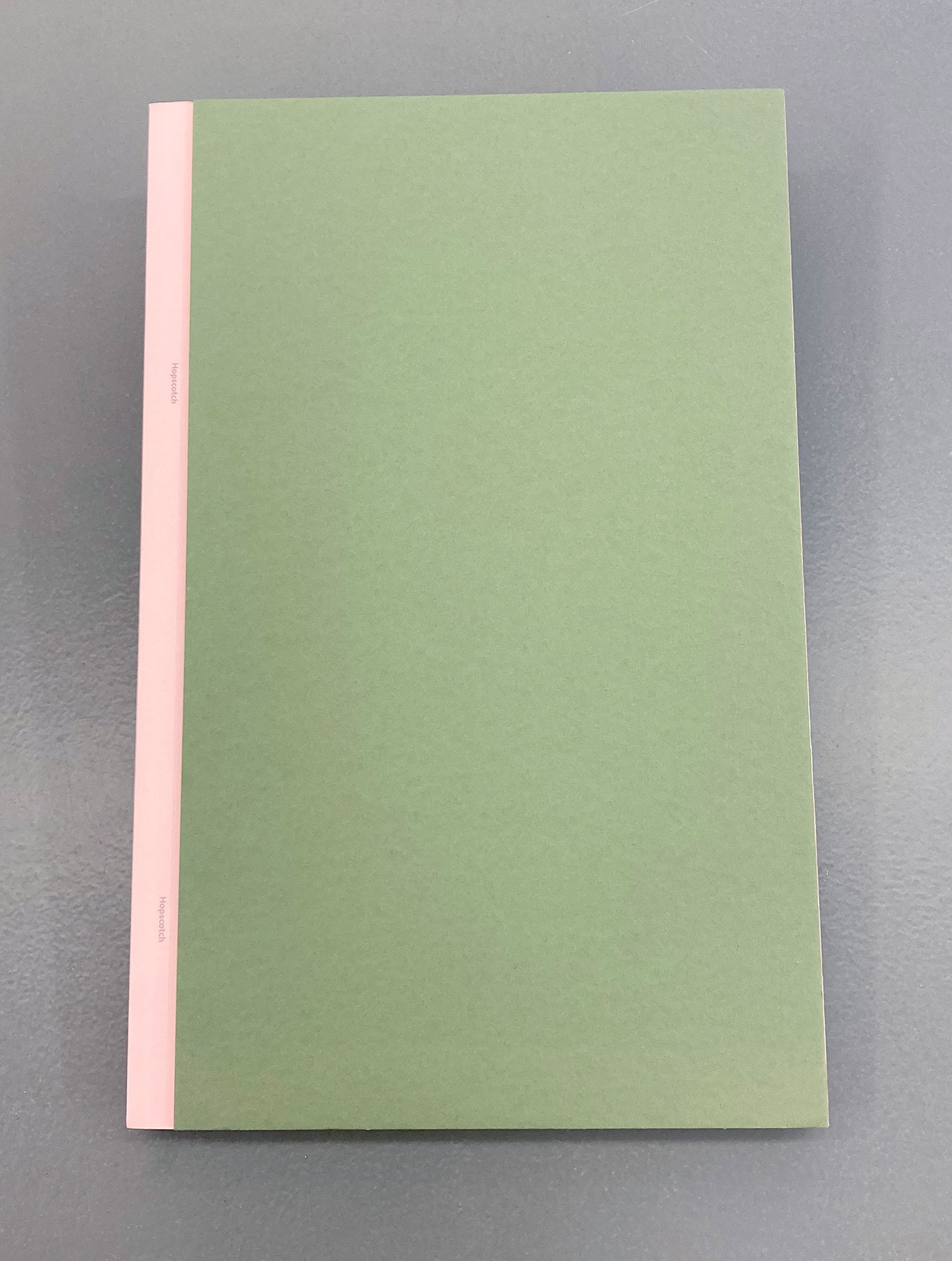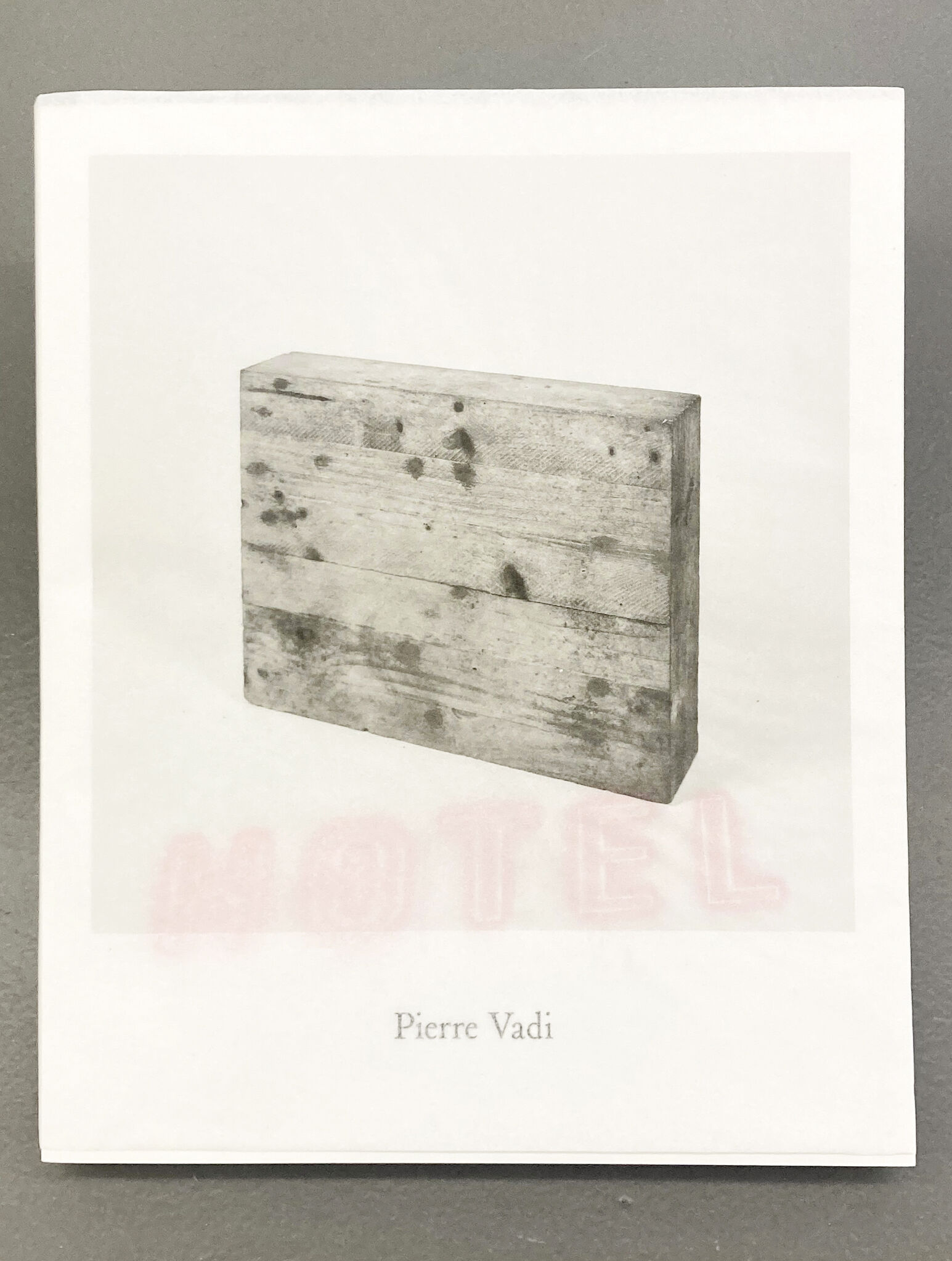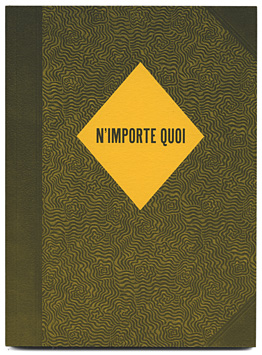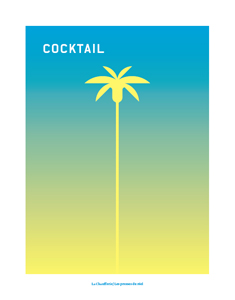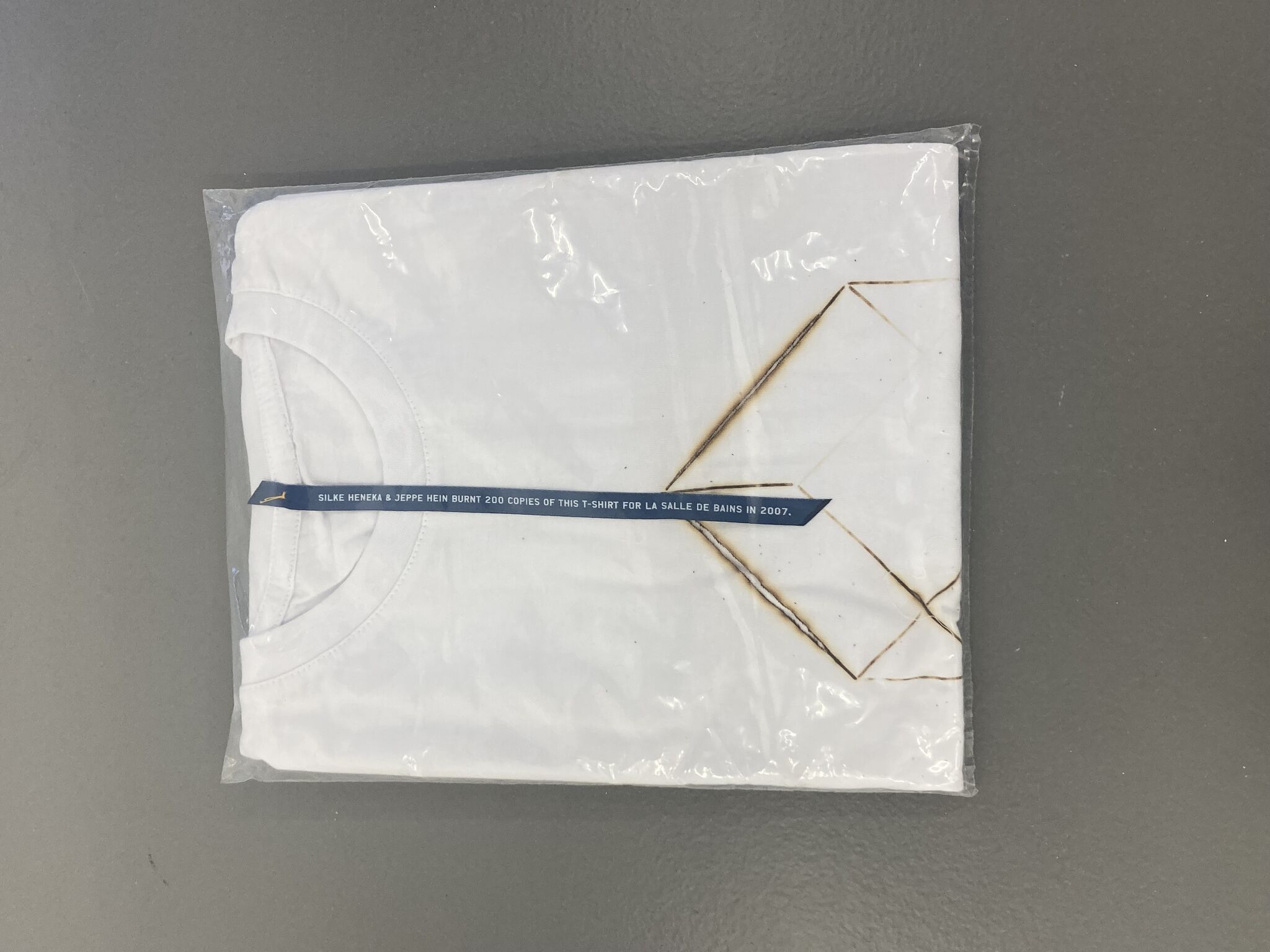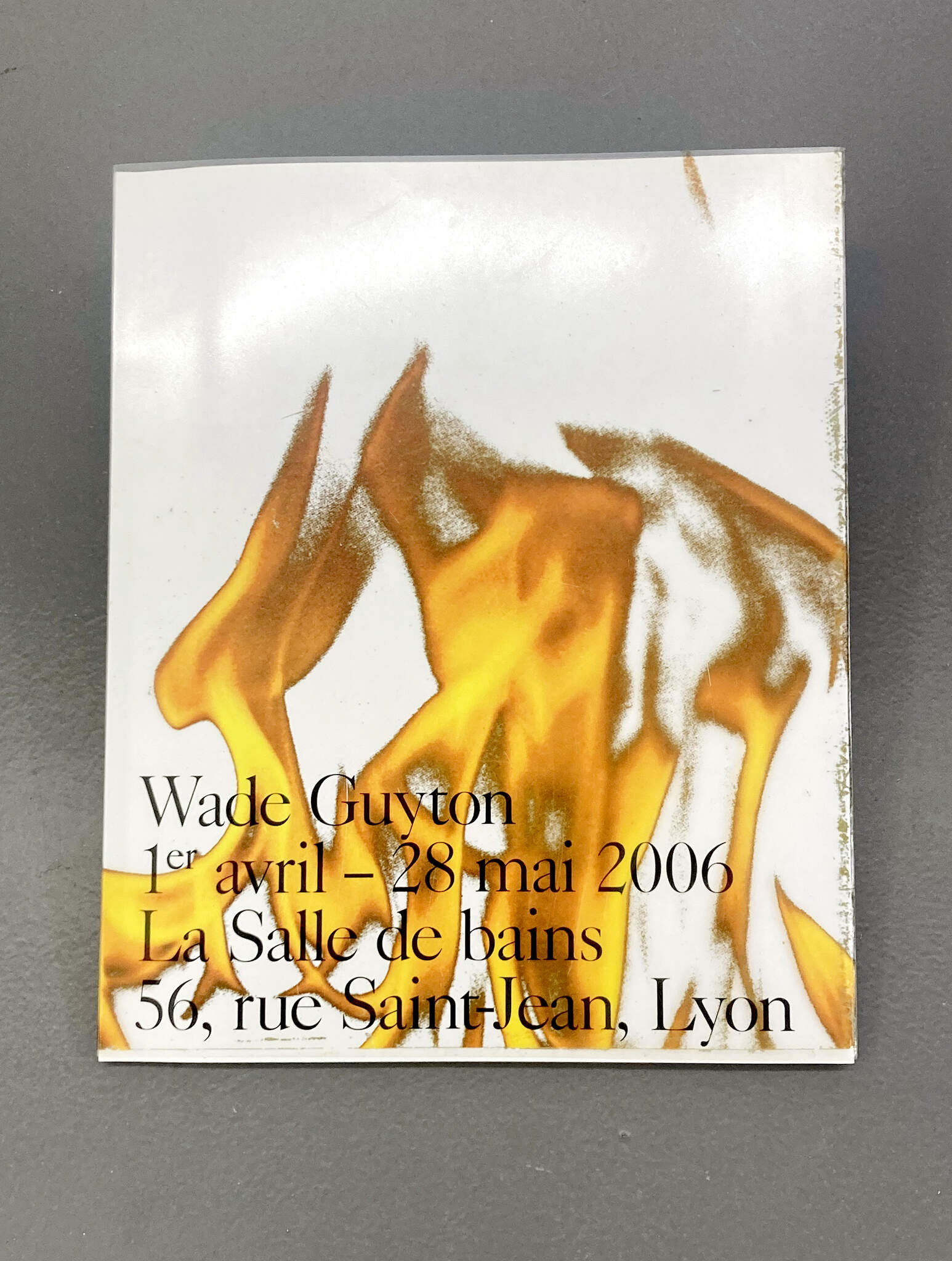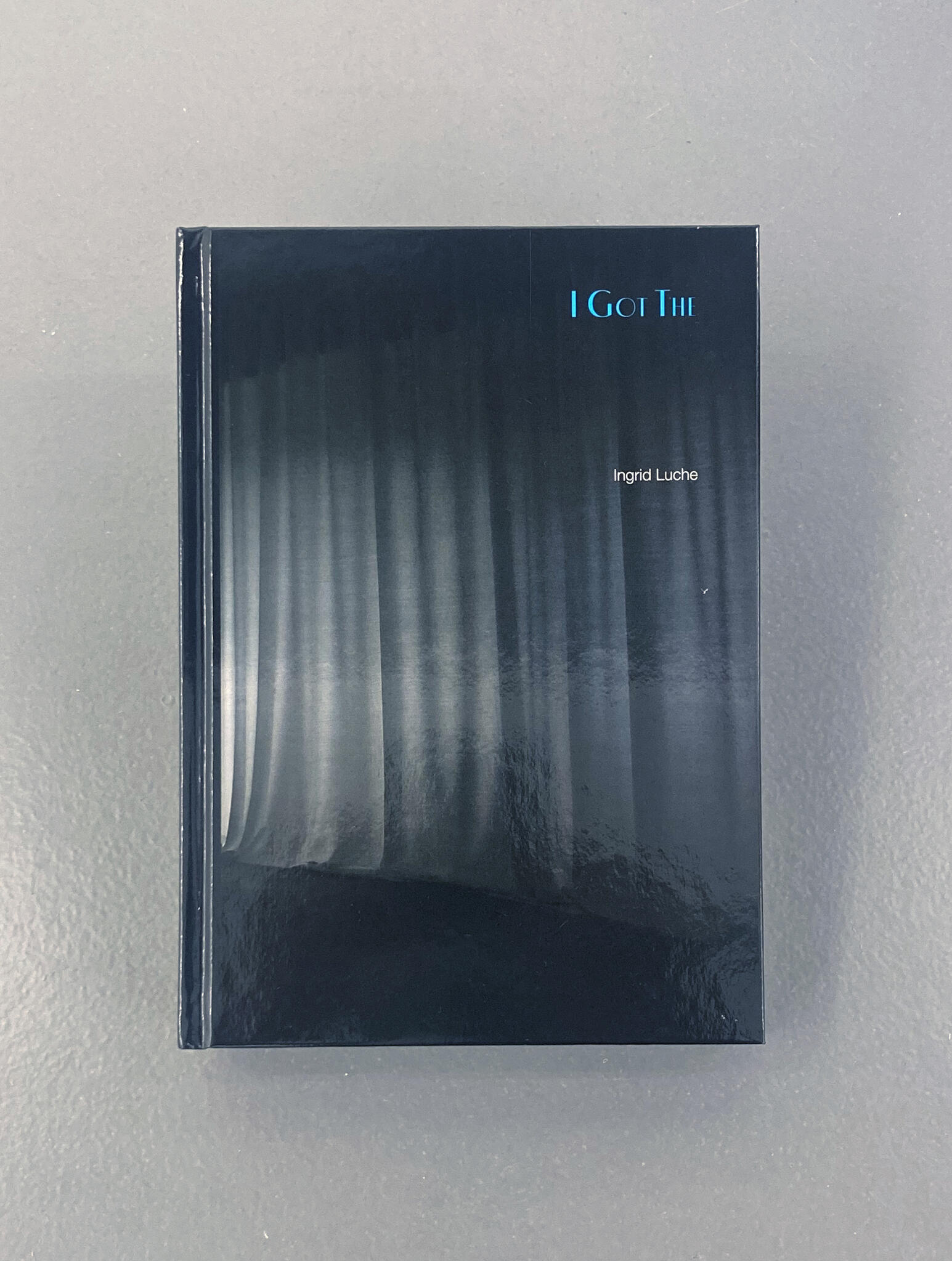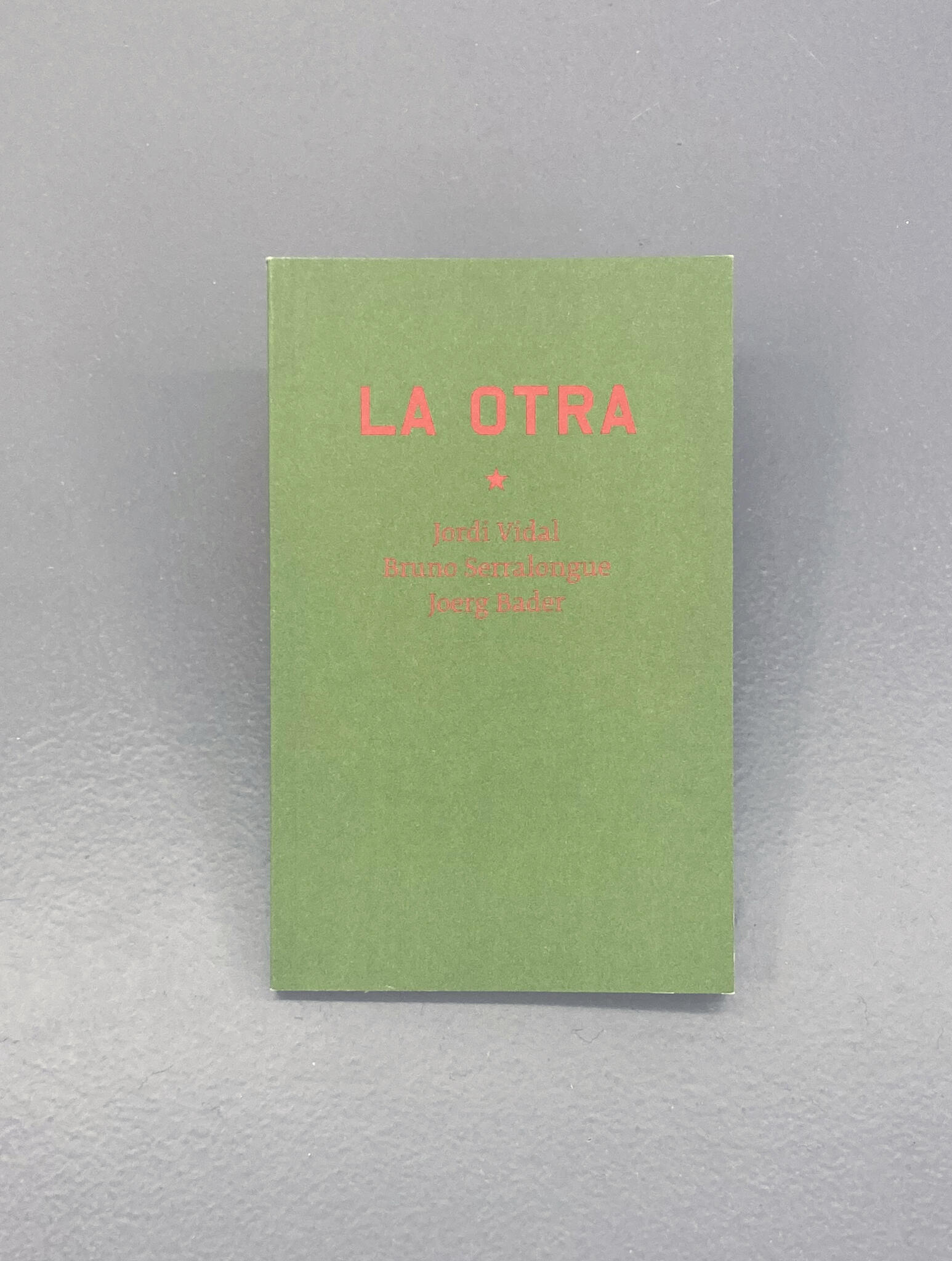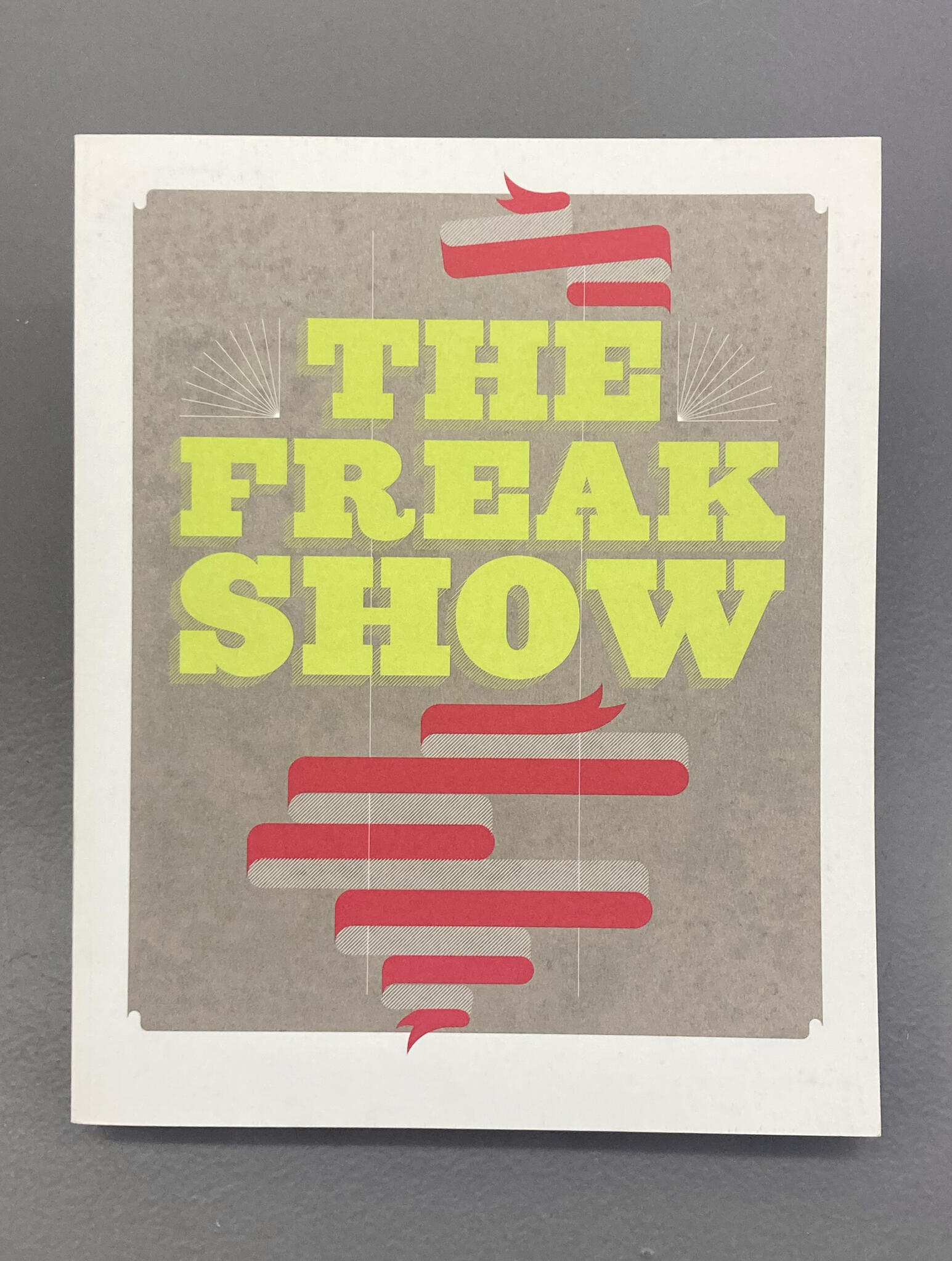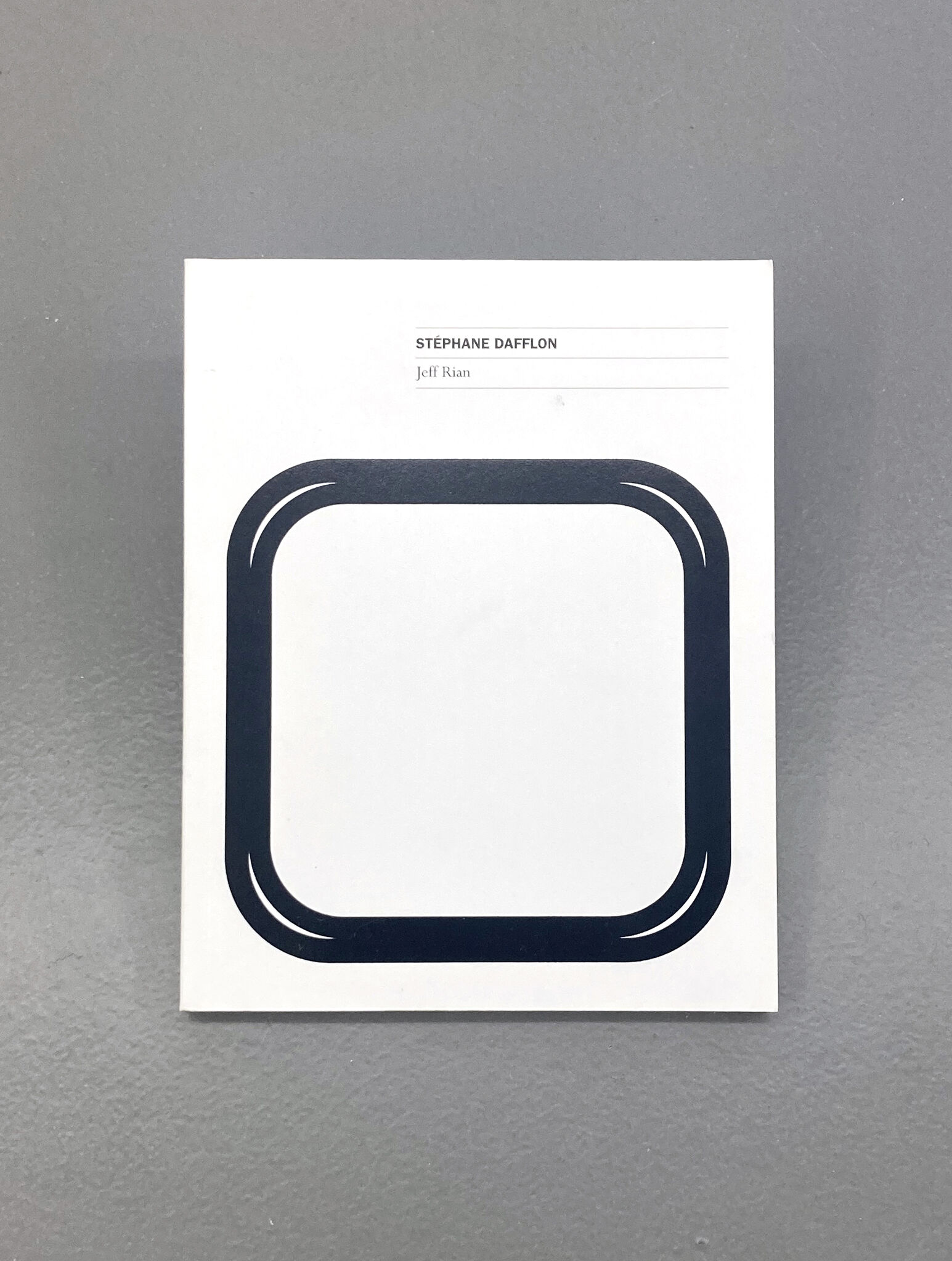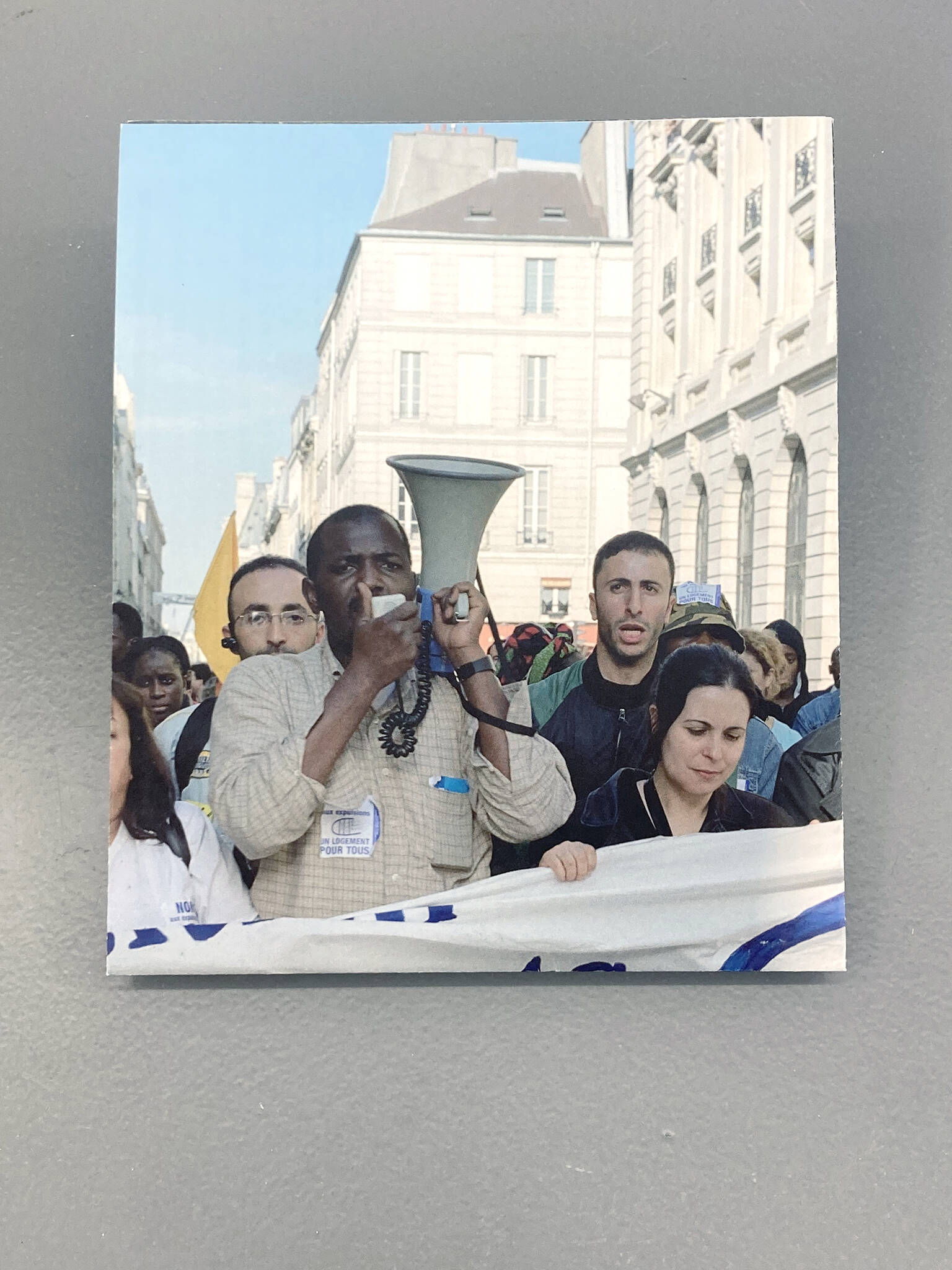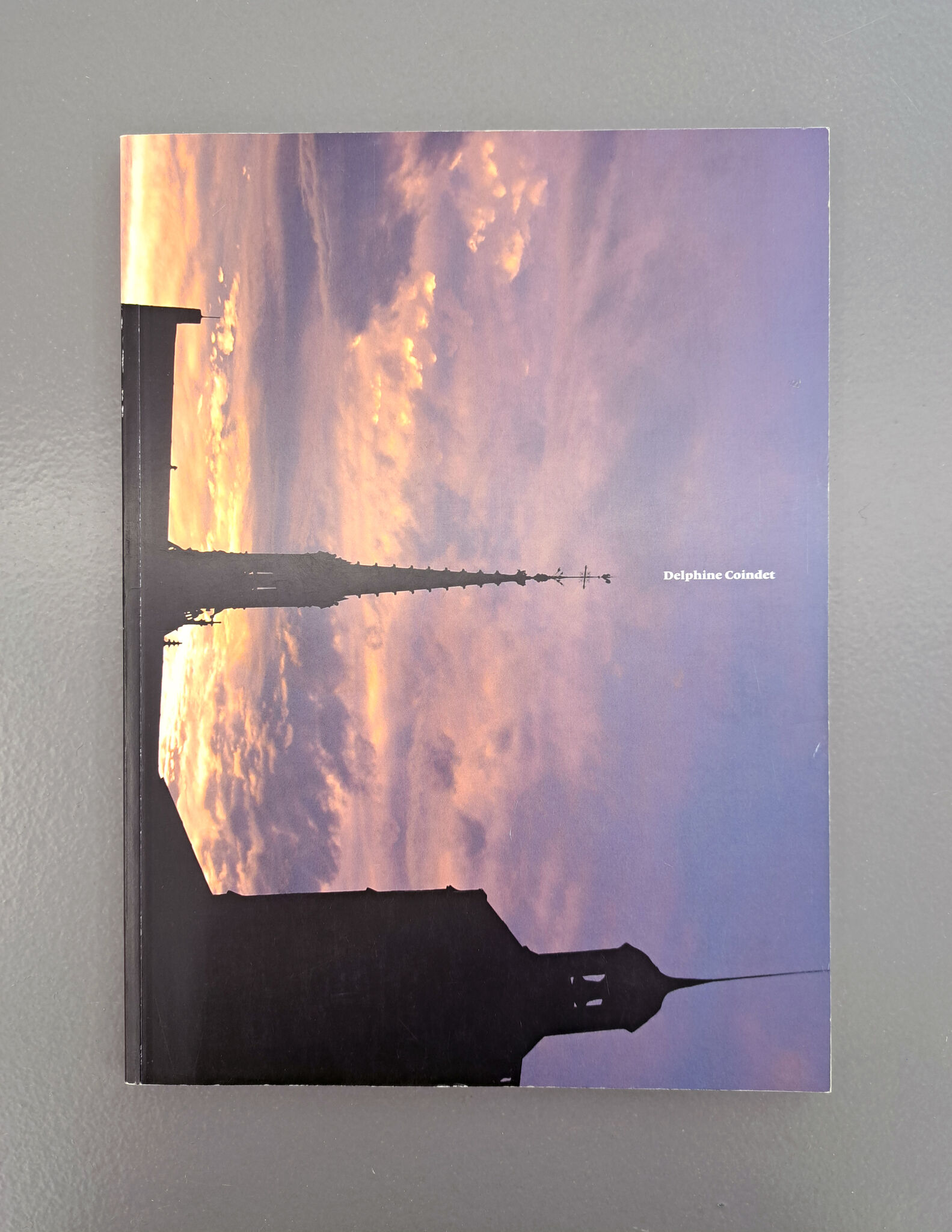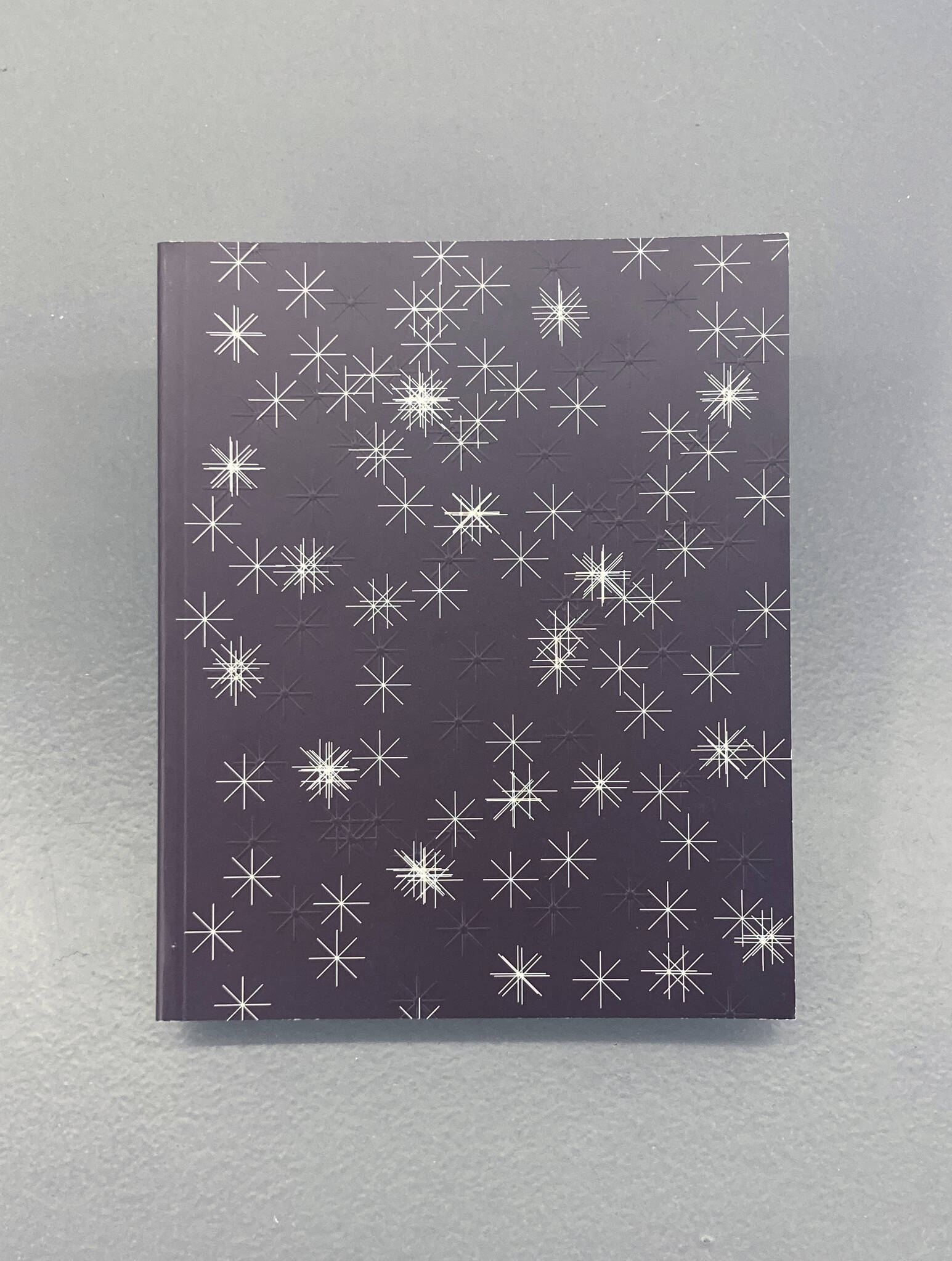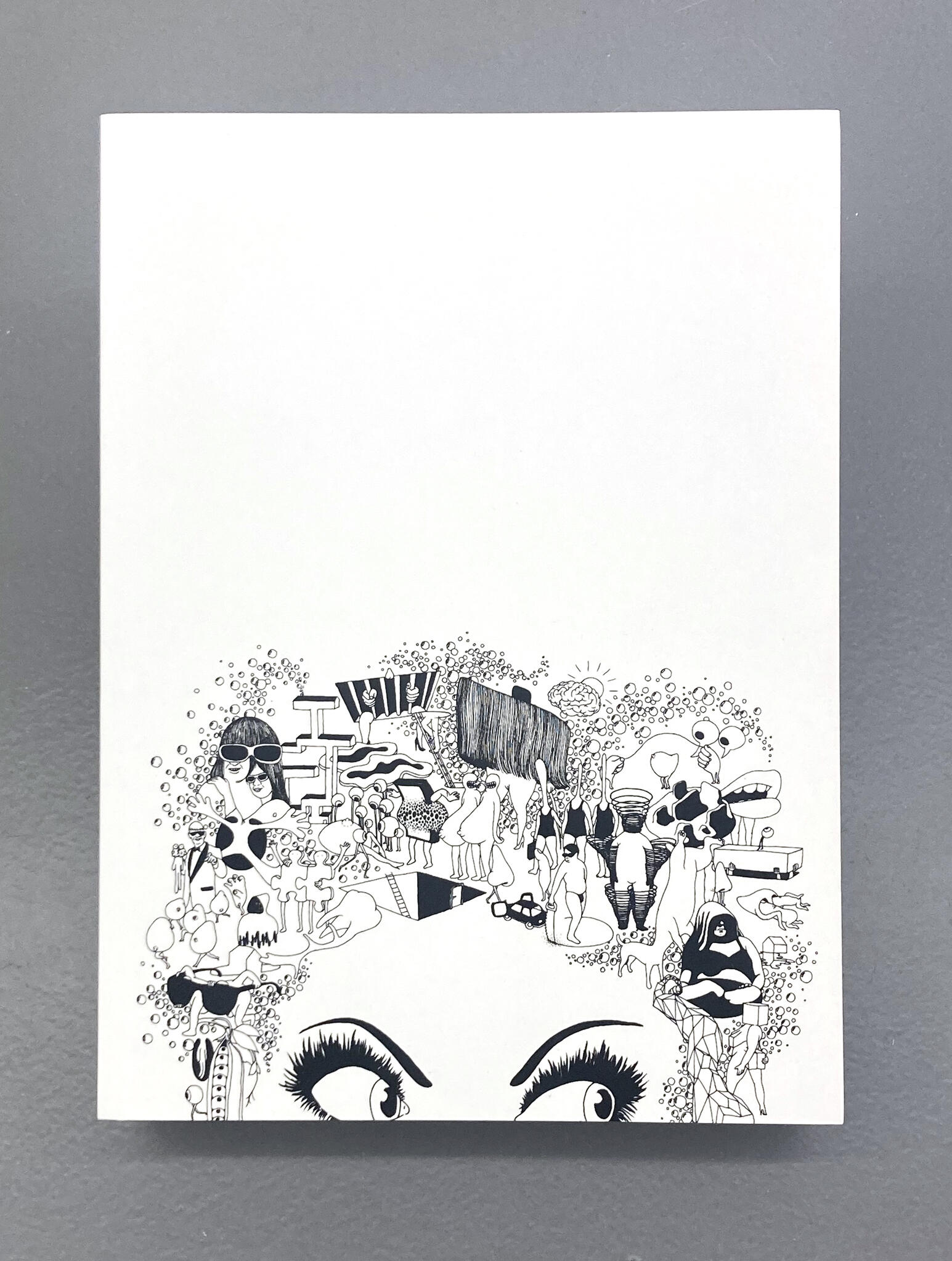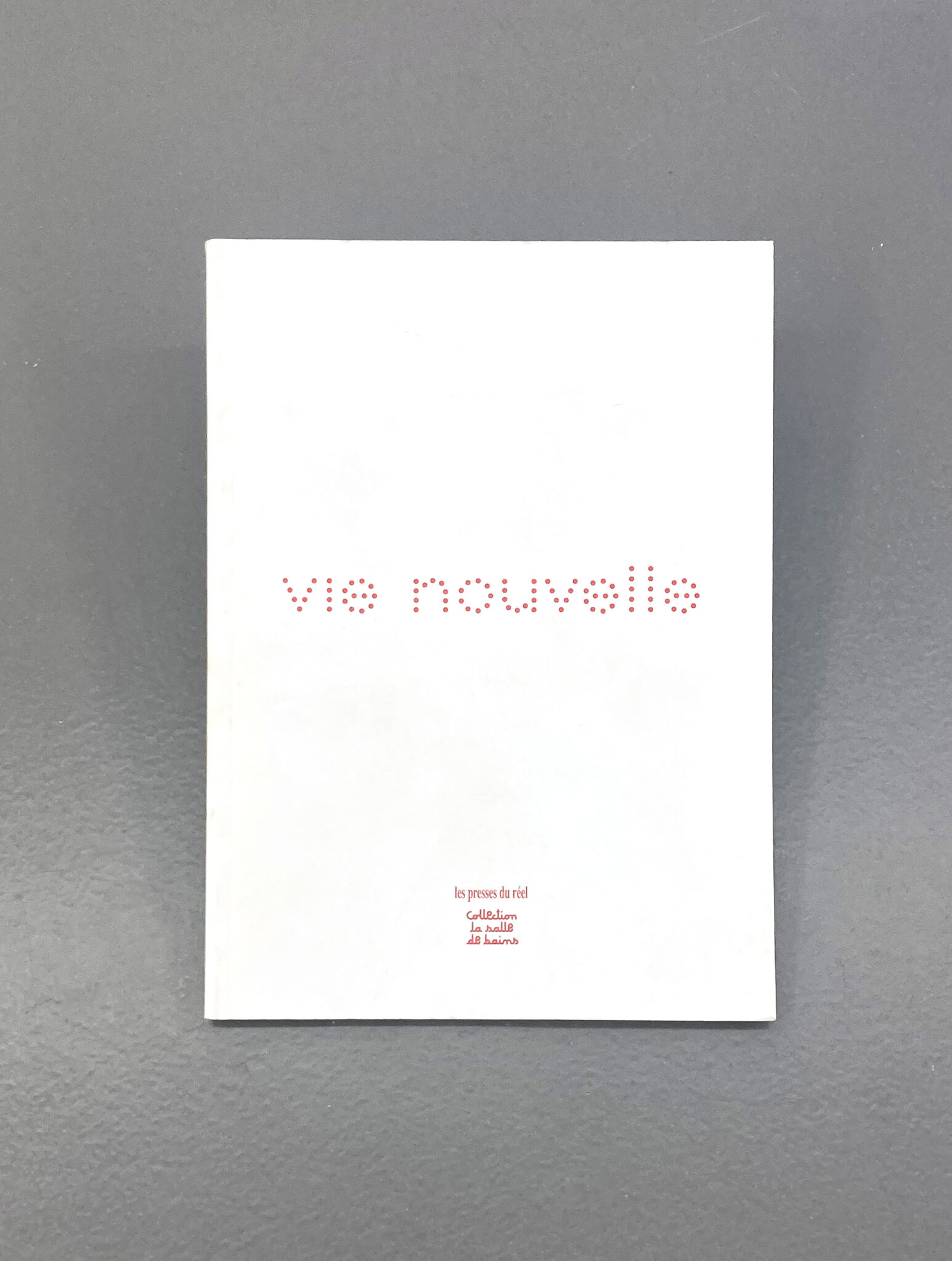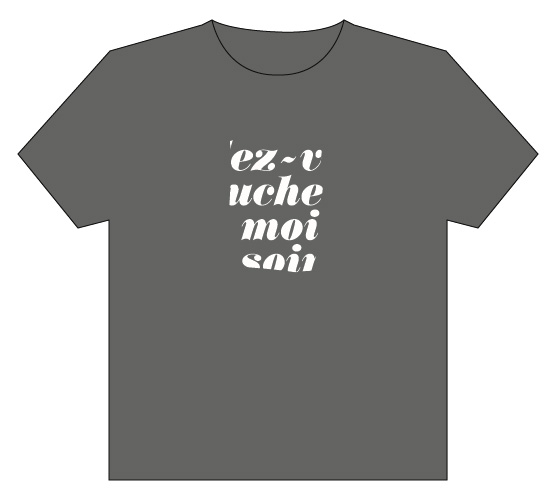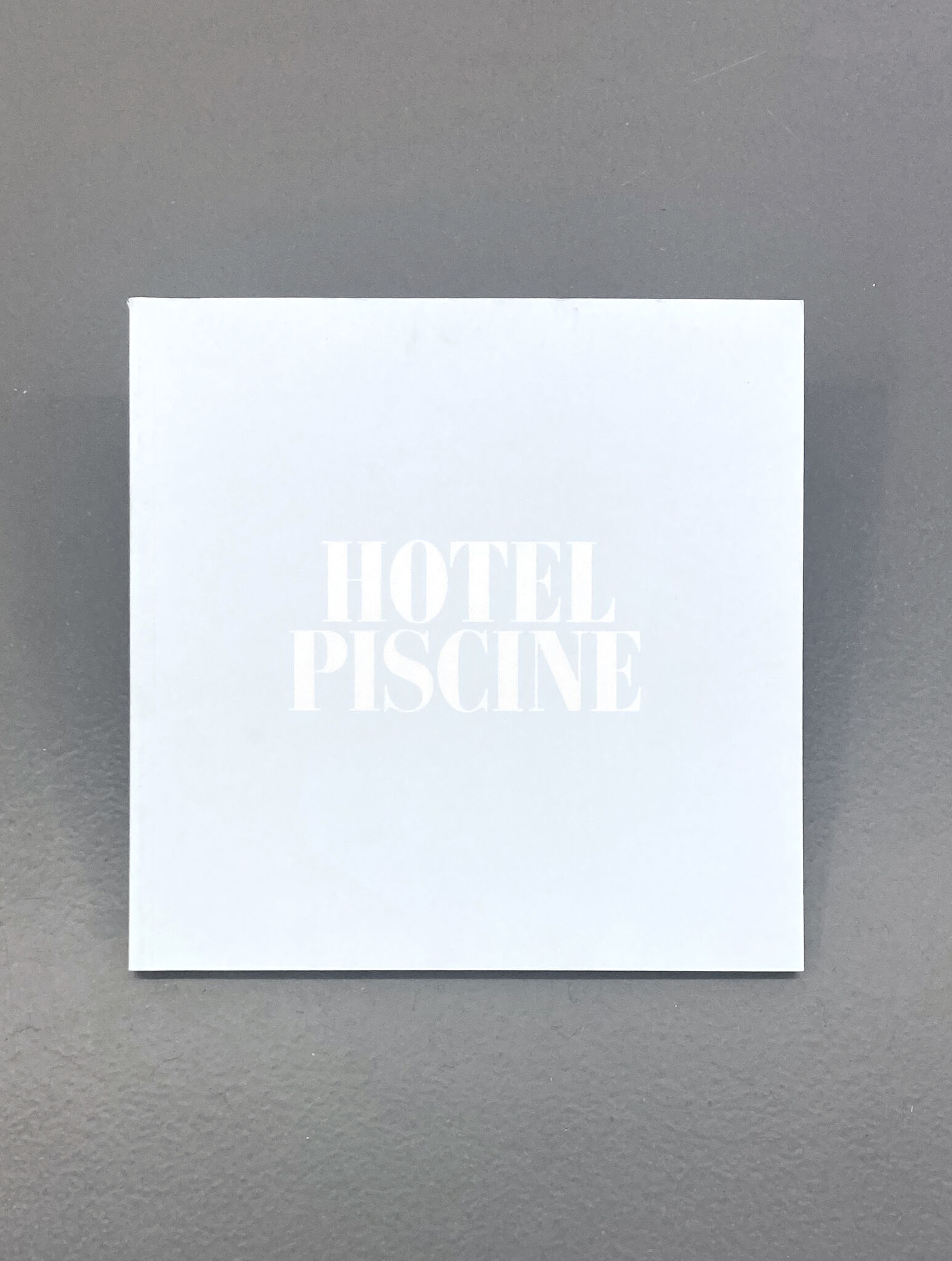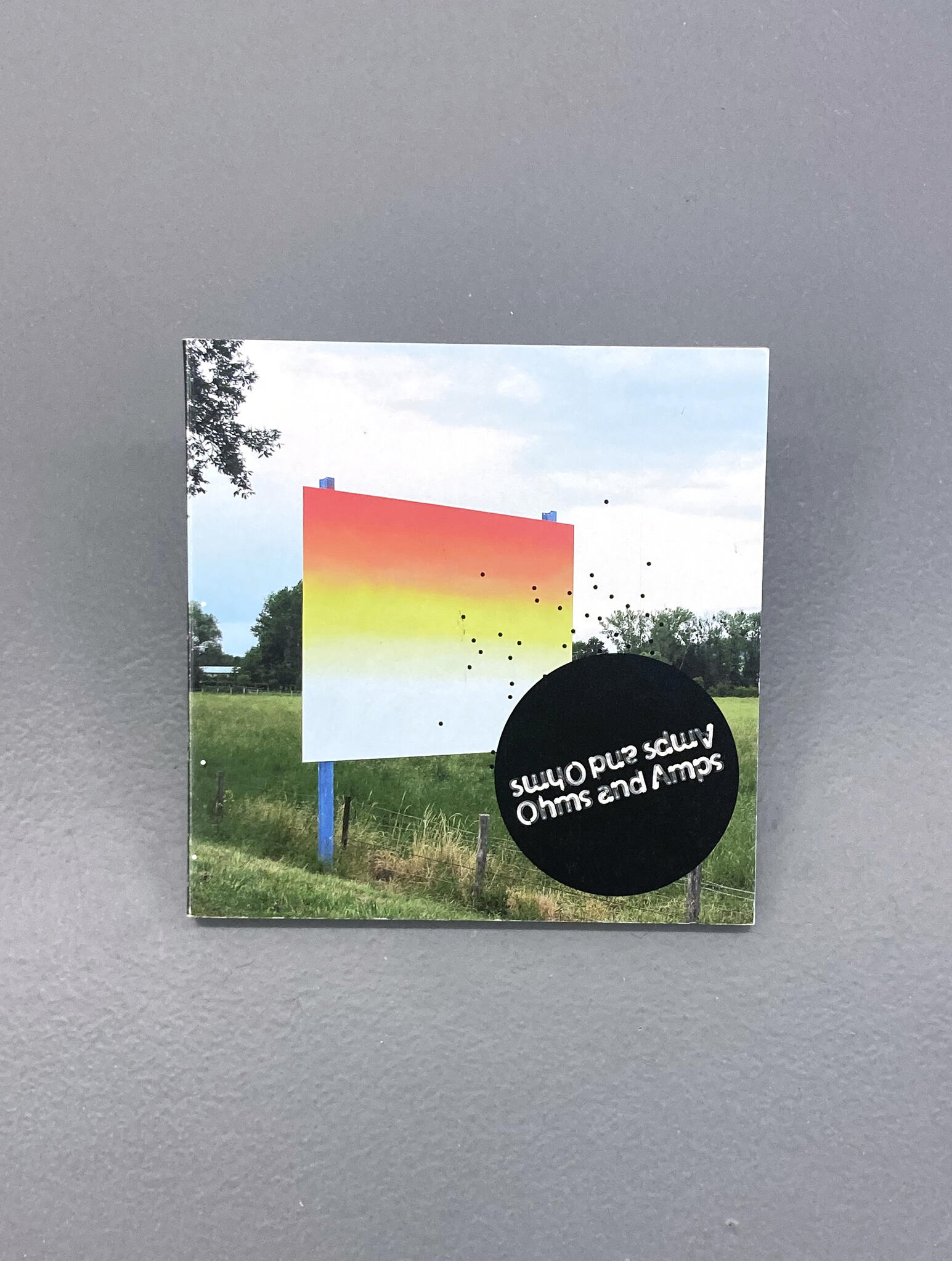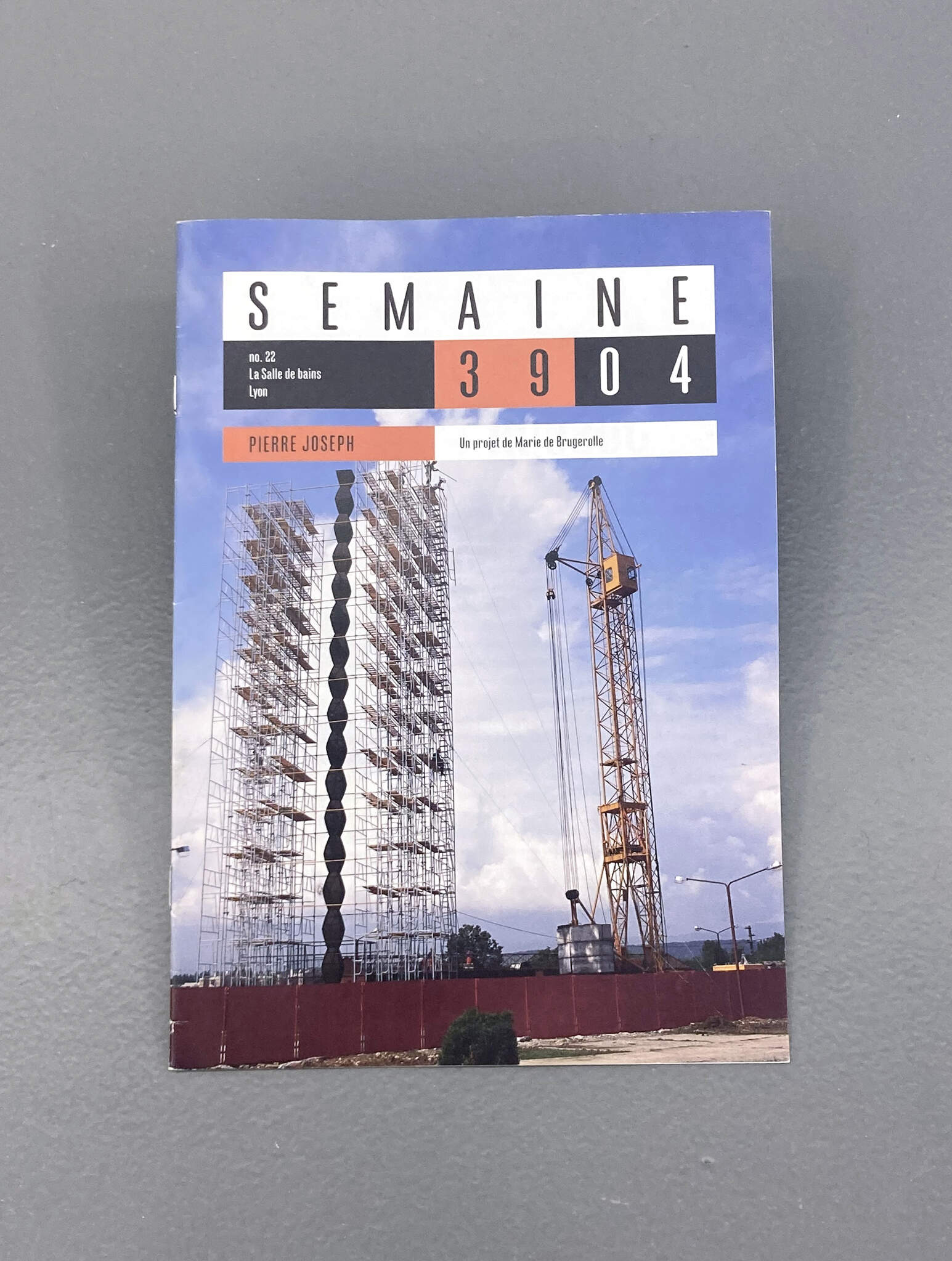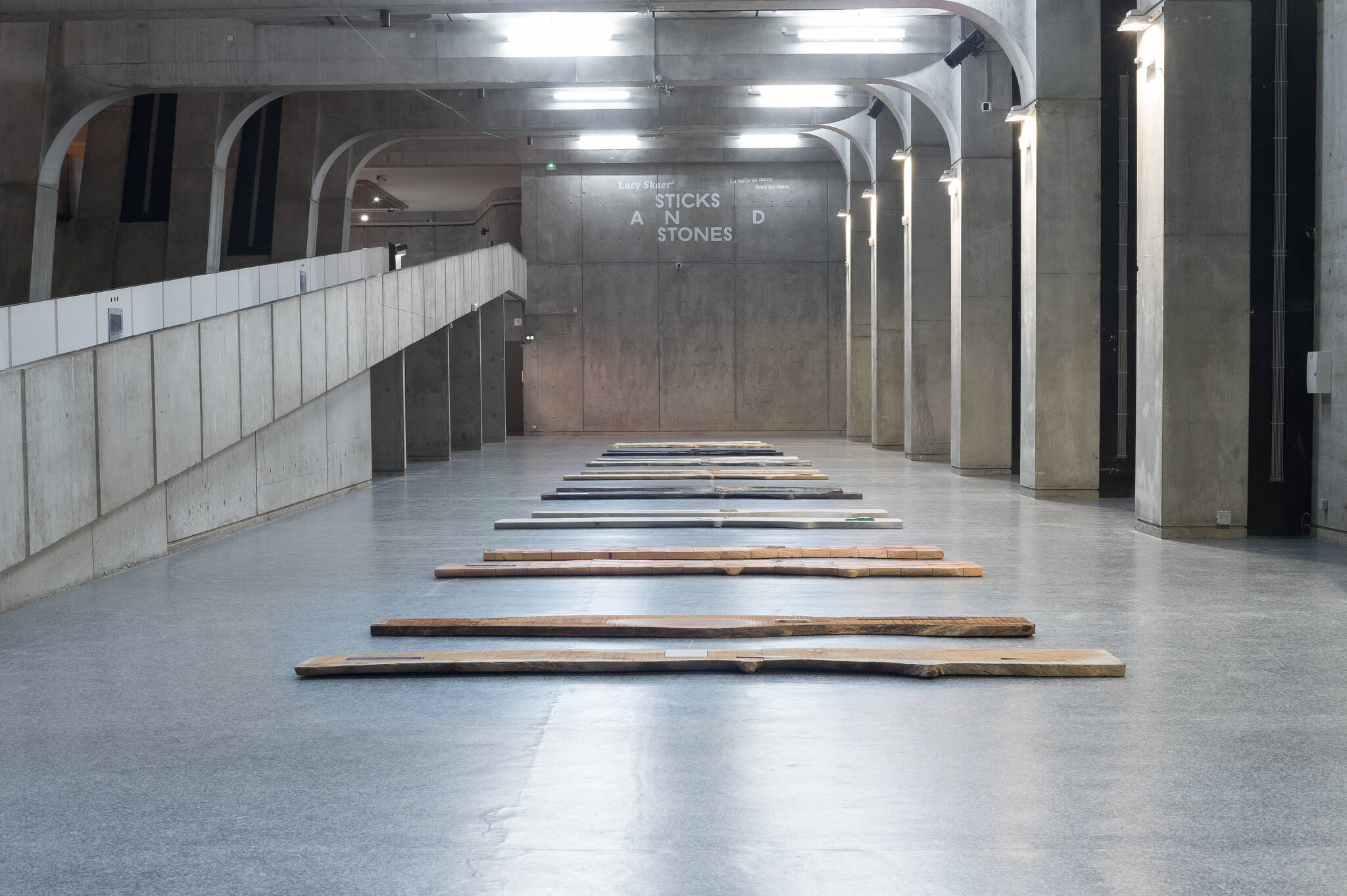
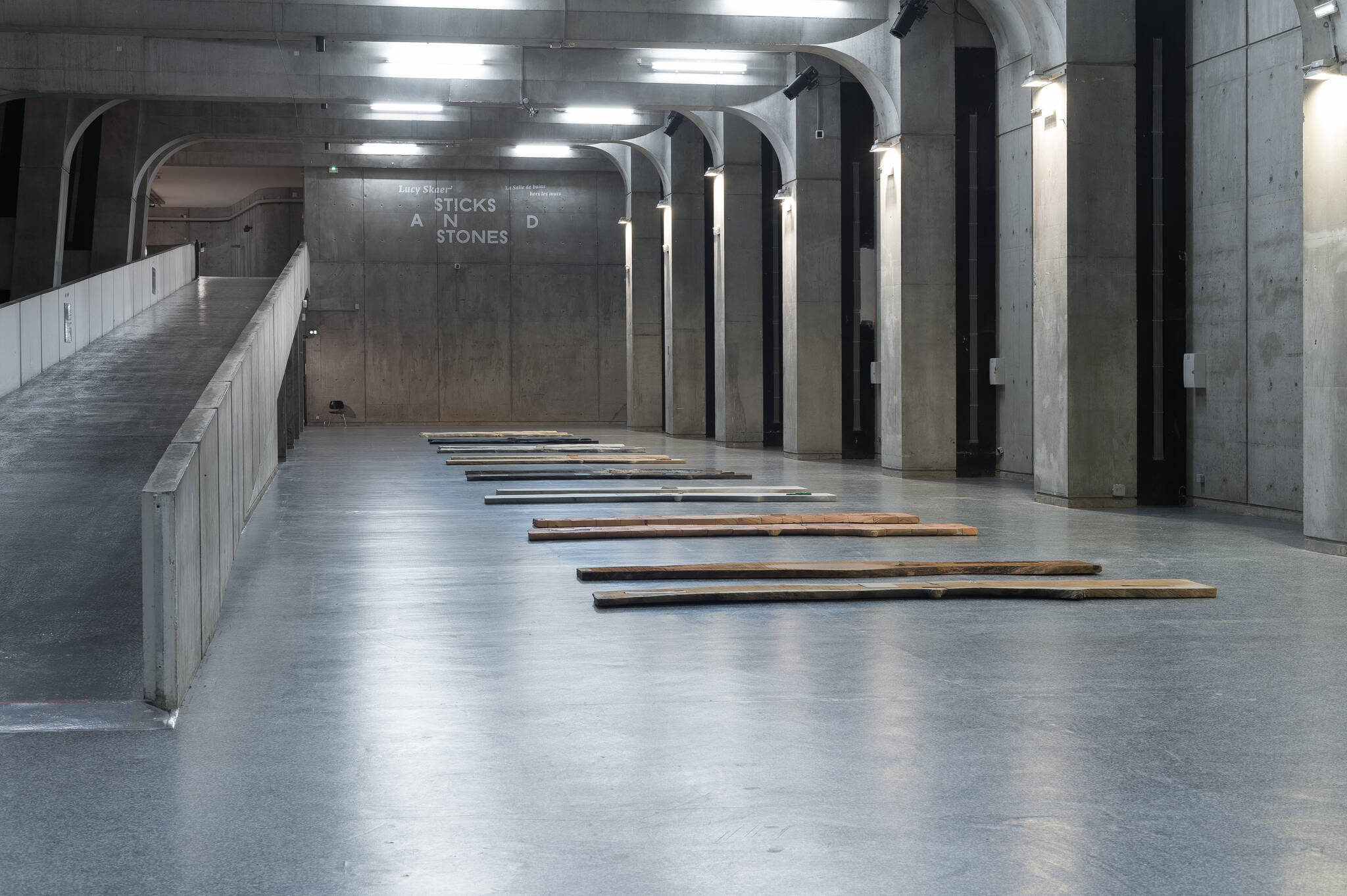

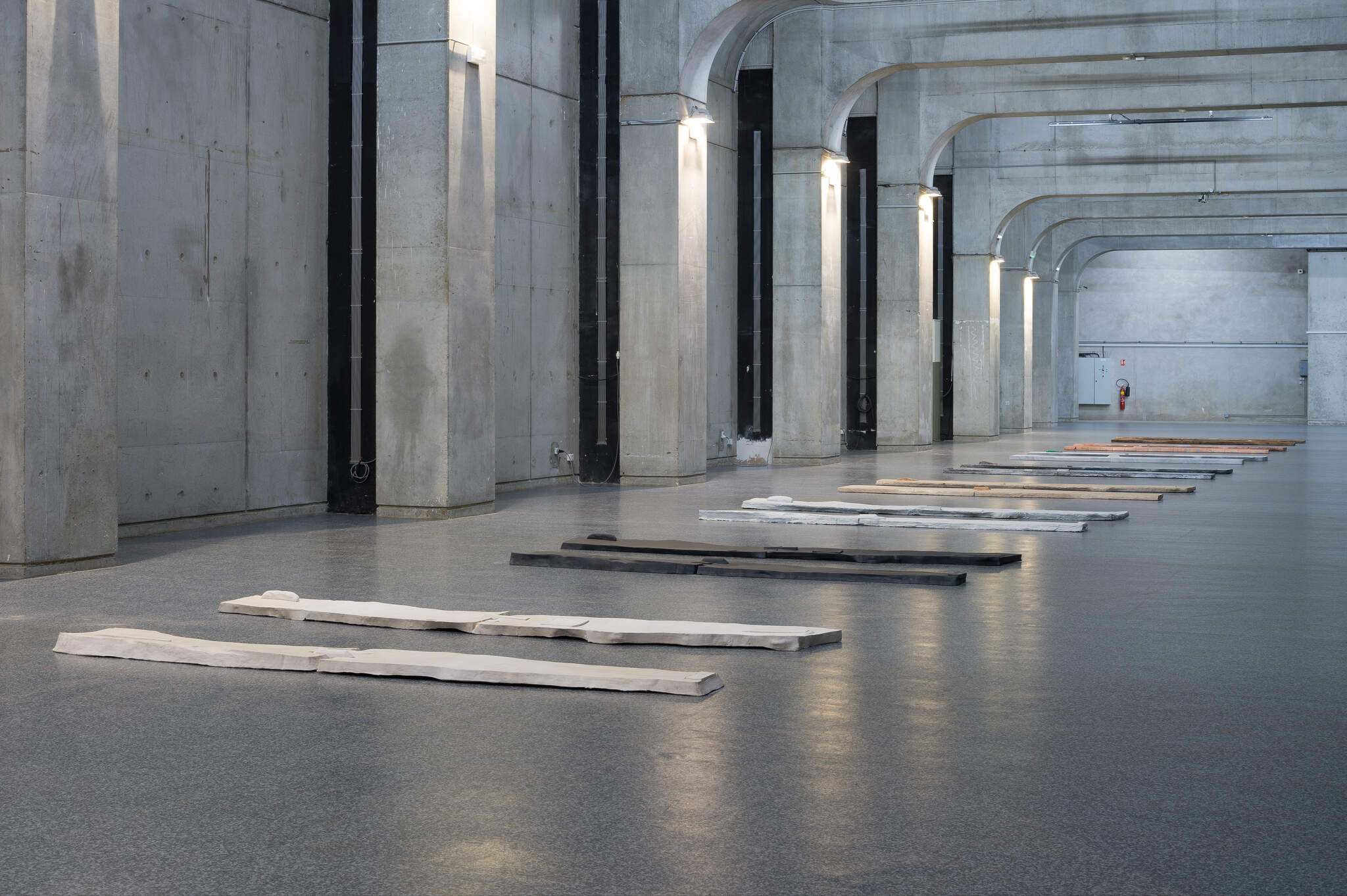
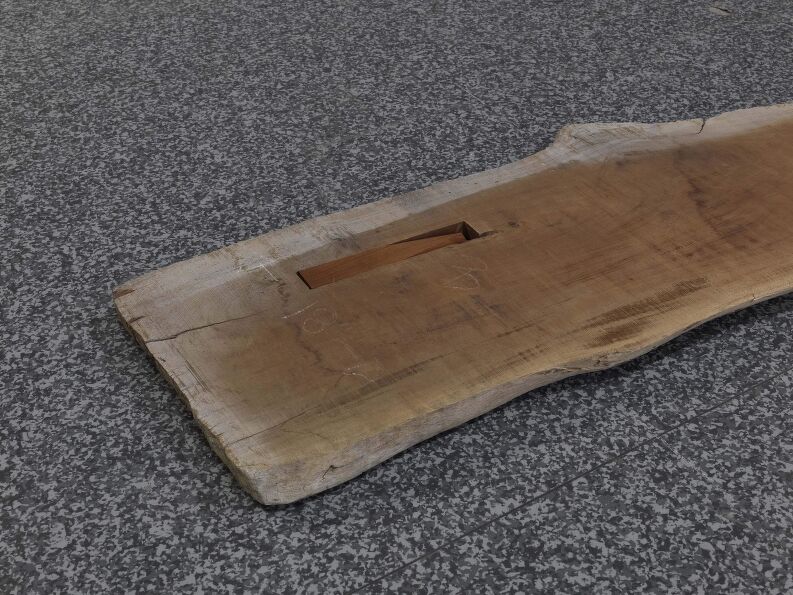
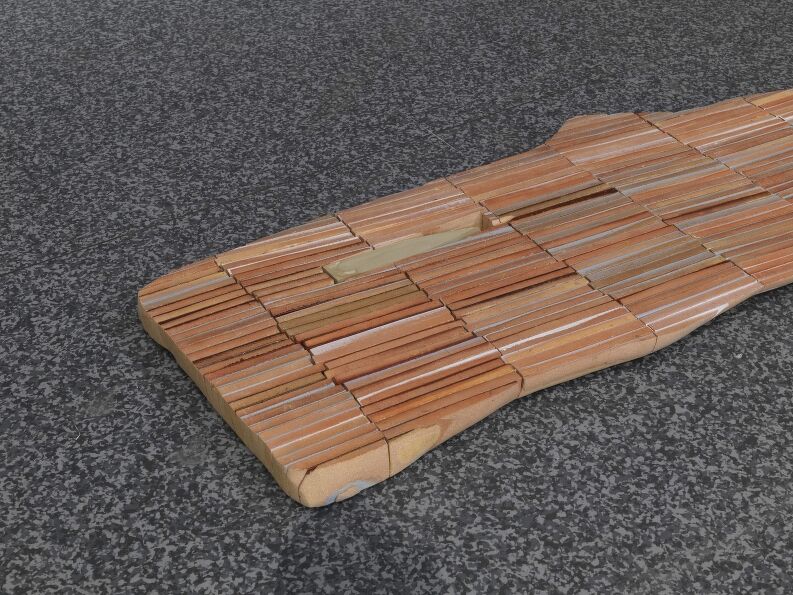
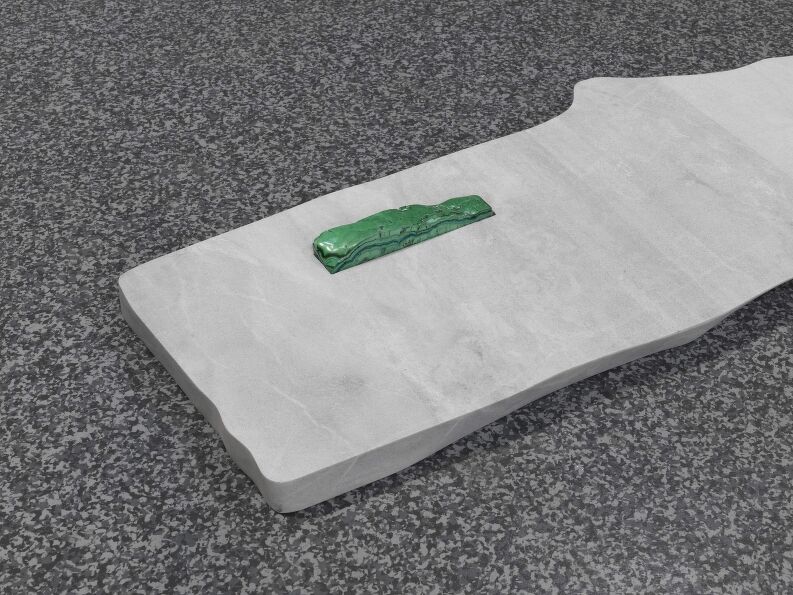
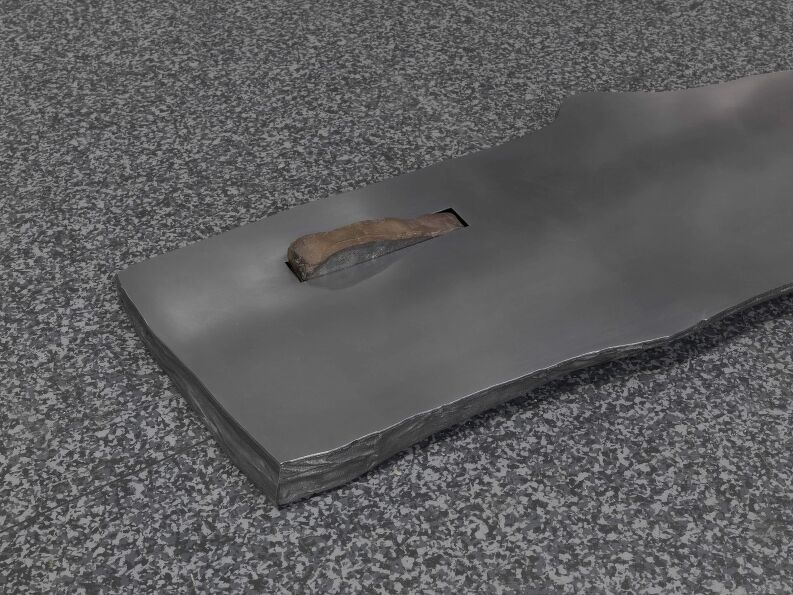
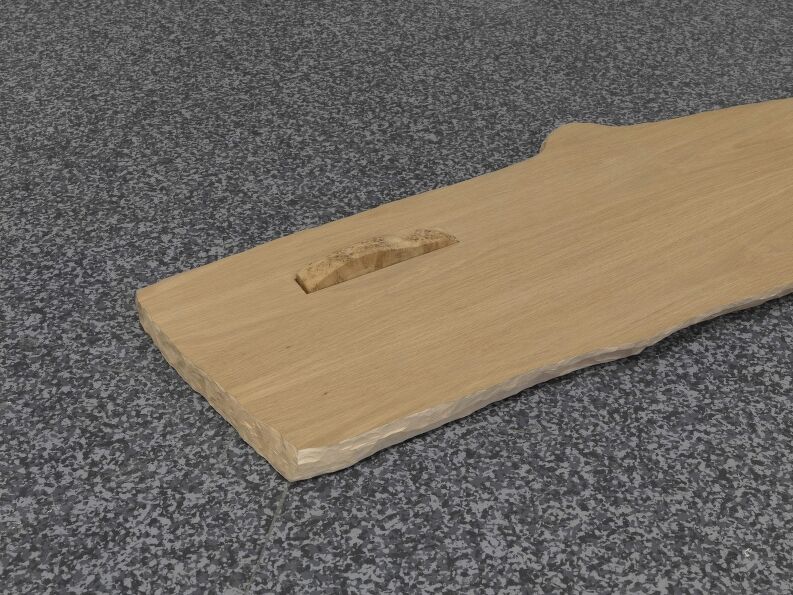
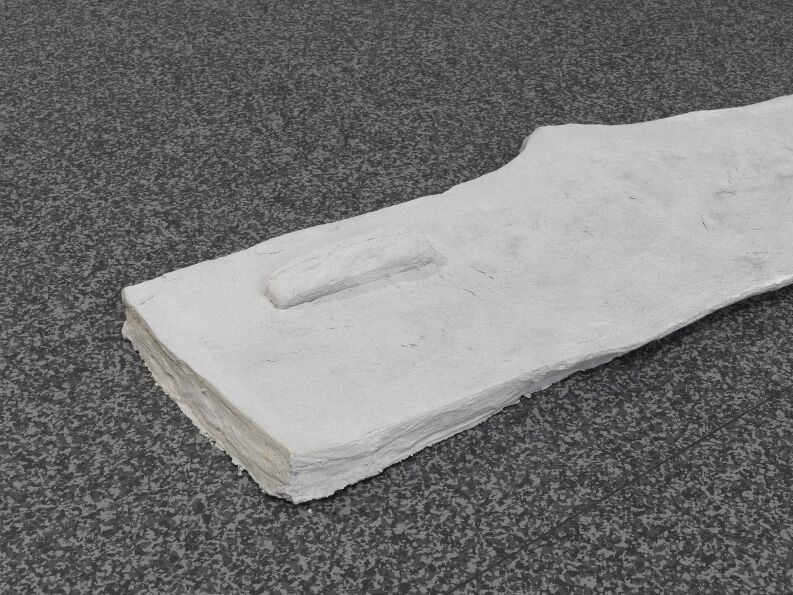
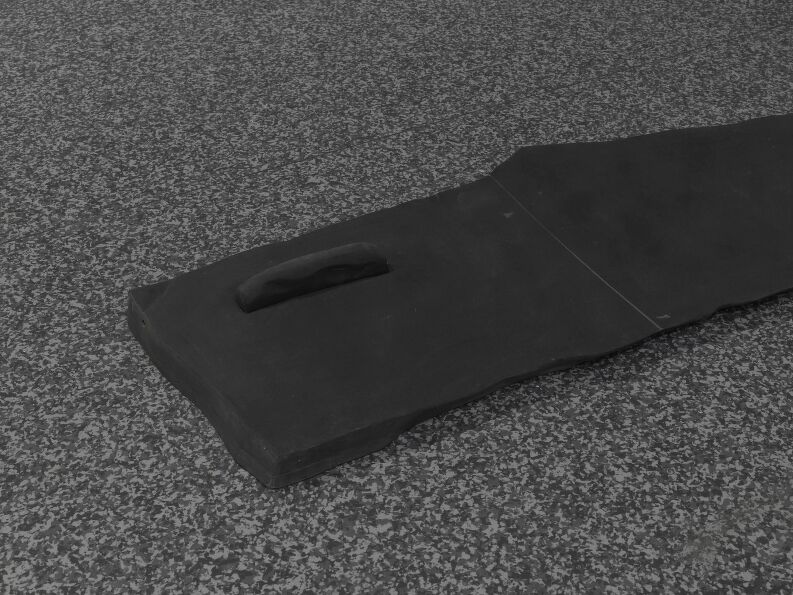
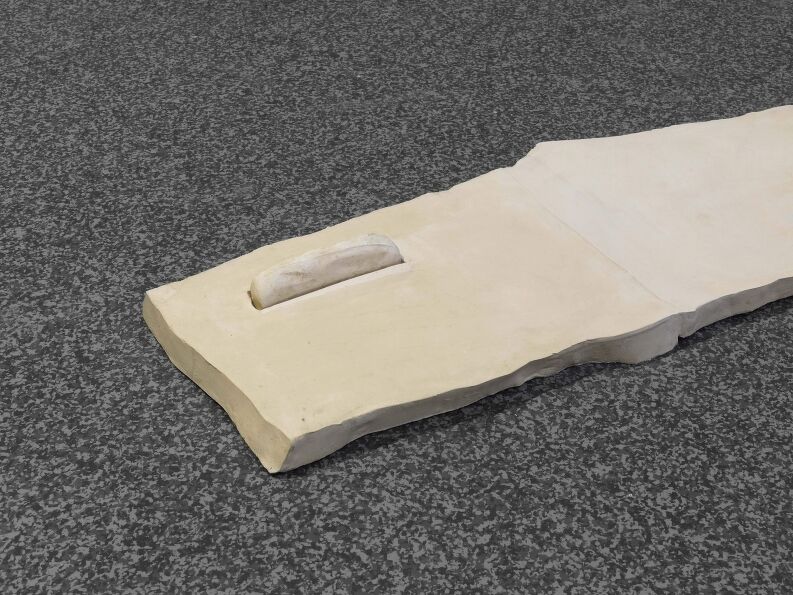
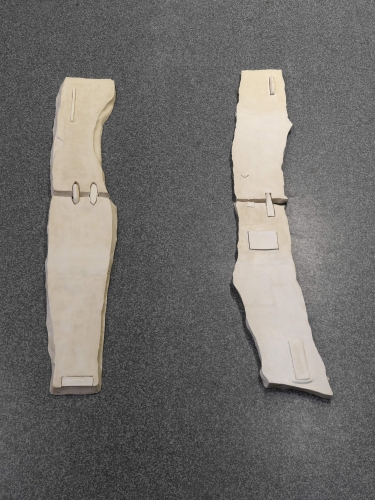
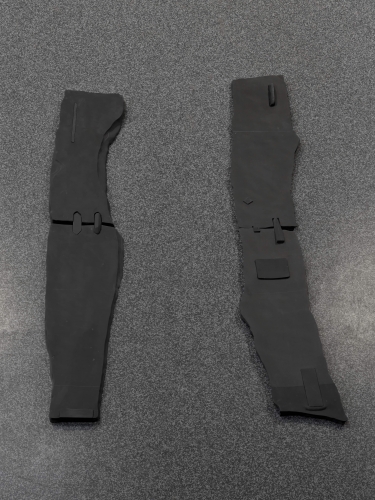
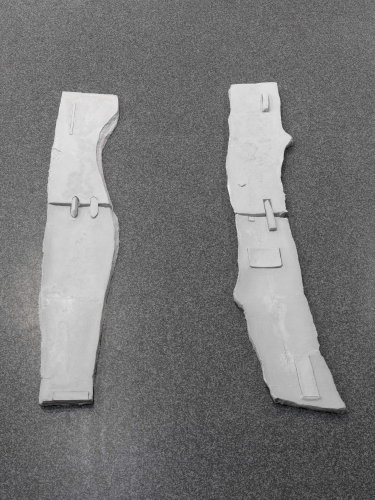
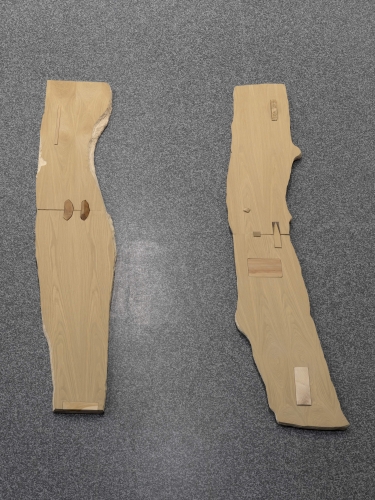
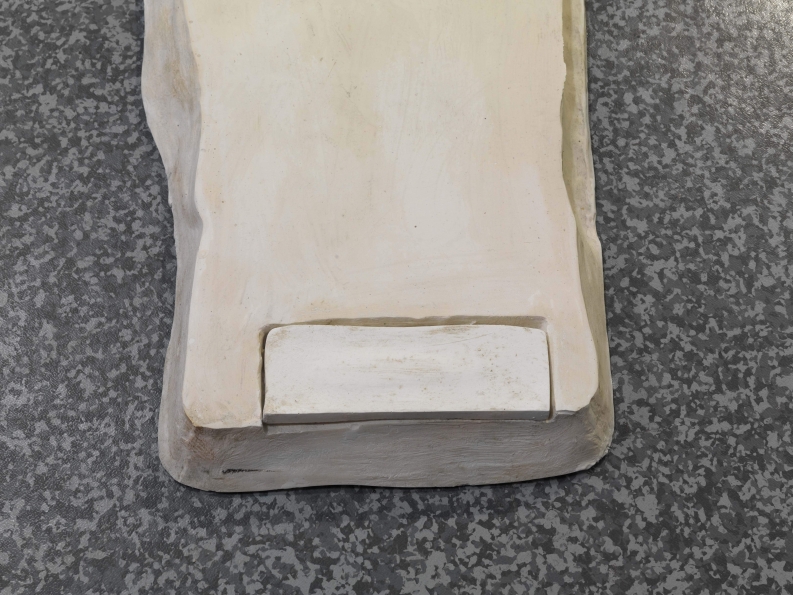
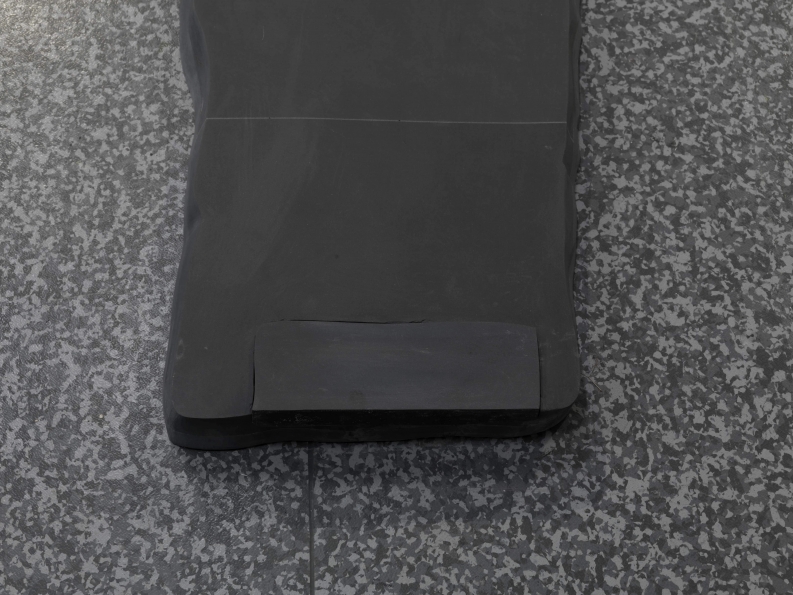
Lucy Skaer, Sticks And Stones, Musée Gallo-Romain, la Salle de bains hors les murs, Lyon, 2015. Photos : Aurélie Leplatre
Lucy Skaer, Sticks And Stones, Musée Gallo-Romain, la Salle de bains hors les murs, Lyon, 2015. Photos: Aurélie Leplatre
Sticks And Stones
Du 10 avril 2015 au 3 janvier 2016From 10 April 2015 to 3 January 2016
Hors les murs → Musée gallo-romain de Lyon-Fourvière
Musée Gallo-Romain de Lyon-Fourvière
17 rue Cléberg
FR-69005 Lyon
Sticks and Stones est une série de sculptures que l’artiste écossaise Lucy Skaer a initiée en 2013 à partir d’une planche d’acajou rouge (mahogany en anglais). Appelé également « acajou de Bélize », ce bois porte le nom du fleuve qui est aussi celui de l’ancienne colonie britannique centre-américaine. Cette essence précieuse et sacrée a été exploitée de la fin du XIXe siècle aux années cinquante pour la fabrication de navires et surtout exportée en masse via le fleuve Bélize pour la production de meubles peu coûteux fabriqués au Royaume-Uni.
L’échantillon de ce bois (une planche de 250 × 80 × 15 cm) chargé d’histoires et qui a servi à l’artiste de point de départ de la série a la particularité d’être resté immergé au fond du fleuve pendant presque un siècle. Sa texture a été sculptée par l’eau et porte donc en plus de ses caractéristiques naturelles les traces de son immersion prolongée, révélant un destin relativement courant pour des arbres dont la voie principale d’exportation était le fleuve.
Récemment, grâce à des méthodes écologiques et au commerce équitable certains de ces troncs ont été sortis du fleuve, donnant ainsi une seconde vie a ce matériau, sorte de rebut de la colonisation.
À partir de cette planche d’acajou, Lucy Skaer a ensuite réalisé des copies déclinées en divers matériaux comme le marbre, l’aluminium, le bronze et le papier mâché. La forme initiale de l’objet a ainsi progressivement évolué devenant de plus en plus abstraite et offrant une série d’étranges sculptures horizontales posées à même le sol. Chaque nouvelle sculpture est moulée ou fabriquée par un artisan ou par l’artiste elle-même à partir de la précédente, il n’y a donc pas d’original, chaque œuvre copie la forme de la précédente en s’adaptant aux contraintes techniques lorsque le moulage n’est pas possible, il s’agit donc davantage d’un ensemble de variations.
Les matériaux des sculptures ont été choisis par l’artiste de manière intuitive, par association de couleurs ou d’idées. Aucune règle, ni système n’articulent ces compositions abstraites, il s’agit davantage de procéder par impression, par émotion ou projection mentale afin d’imaginer en amont l’évolution formelle de cet objet à travers les techniques de moulage, de tirage ou de réplique, le tout pour générer une nouvelle « copie » ou plutôt un nouveau modèle, légèrement différent du précédent et du suivant.
À travers cette variation sculpturale, différentes strates ou connotations historiques, culturelles et naturelles s’inscrivent dans l’épaisseur ou à la surface des objets jouant également d’un point de vue artistique et anthropologique sur les multiples significations et nuances que recouvrent les notions d’échantillons, de moules, de copies, de répliques ou encore de prototypes.
Le contexte du musée gallo-romain fait d’autant plus résonner cette dimension stratigraphique de l’œuvre. Plusieurs couches et significations coexistent dans un seul et même objet, son utilisation peut avoir été diverse et évolutive au fil des siècles. L’Histoire et les récits se superposent dans l’œuvre de Lucy Skaer comme dans de nombreux objets archéologiques de la collection du musée.
Depuis leur création, puis leur découverte ou leur extraction, jusqu’à leur re-découverte par l’interprétation qu’elle soit scientifique ou fantasmée, les objets portent les traces de plusieurs histoires et d’un savoir qui nourrit le creuset de nos imaginations.
Hors les murs → Musée gallo-romain de Lyon-Fourvière
Musée Gallo-Romain de Lyon-Fourvière
17 rue Cléberg
FR-69005 Lyon
Sticks and Stones is a series of sculptures that Scottish artist Lucy Skaer initiated in 2013 from a red mahogany board. Also known as “mahogany Belize” that wood is named after the river which is also that of the former British colony located in Central America. This precious and sacred essence was operated from the late 19th century for the manufacturing of ships and mostly exported via the Belize River for the production of inexpensive furniture made in the UK.
The sample of this wood (a board measuring 250 × 80 × 15 cm) is loaded with intertwined stories and served in the series as the starting point for the artist. This piece of mahogany has the distinction of having remained submerged at the bottom of the river for almost a century. Its texture was sculpted by water and is therefore in addition to its usual features the footsteps of his prolonged immersion, revealing a fairly common fate for trees whose main export route was the river.
Recently, through ecological methods and fair trade some of these trunks were taken out of the river, giving a second life to this material which is in some ways a waste of the colonization.
From this mahogany board, Lucy Skaer then made copies declined in various materials such as marble, aluminum, bronze and papier maché. The initial shape of the object has gradually evolved becoming increasingly abstract and offering a series of strange horizontal sculptures placed simply on the floor. Each new sculpture is a cast on the previous and so there is no original, each work copying the shape of the previous or adapting the shape according to the technical constraints of the material, especially when the mold is not possible for instance. So the sculpture keep the same form but become thus more like a set of variations.
Intuitively chosen by the artist, the materials of the sculptures result from color combinations or association of ideas. No rules, no system will come to support the use of the various materials, it is more to proceed by printing, by emotional and mental projection to imagine a formal evolution of this object through molding techniques or replica, all to generate a new “copy” or rather a new model, slightly different from the previous and the next.
Through this sculptural variation, strata or historical, cultural and natural connotations are part of the thickness and the surface of the objects also opening an artistic and anthropological perspective from the manifold meanings articulated by the concepts of samples, molds, copies, replicas or prototypes.
The context of the Gallo-Roman Museum resonates with this stratigraphic dimension of the work. Several layers coexist in a single object, its use may have been diverse and changing over the centuries. History and stories overlap in the work of Lucy Skaer as in many archaeological objects from the museum’s collection.
Since their inception, and their discovery or extraction, until their rediscovery by interpreting it scientifically or fantastically, objects bear traces of several stories and know that nourishes,b eyond periods and geographical areas, the cradle of our imaginations.
Musée Gallo-Romain de Lyon-Fourvière
17 rue Cléberg
FR-69005 Lyon
Sticks and Stones is a series of sculptures that Scottish artist Lucy Skaer initiated in 2013 from a red mahogany board. Also known as “mahogany Belize” that wood is named after the river which is also that of the former British colony located in Central America. This precious and sacred essence was operated from the late 19th century for the manufacturing of ships and mostly exported via the Belize River for the production of inexpensive furniture made in the UK.
The sample of this wood (a board measuring 250 × 80 × 15 cm) is loaded with intertwined stories and served in the series as the starting point for the artist. This piece of mahogany has the distinction of having remained submerged at the bottom of the river for almost a century. Its texture was sculpted by water and is therefore in addition to its usual features the footsteps of his prolonged immersion, revealing a fairly common fate for trees whose main export route was the river.
Recently, through ecological methods and fair trade some of these trunks were taken out of the river, giving a second life to this material which is in some ways a waste of the colonization.
From this mahogany board, Lucy Skaer then made copies declined in various materials such as marble, aluminum, bronze and papier maché. The initial shape of the object has gradually evolved becoming increasingly abstract and offering a series of strange horizontal sculptures placed simply on the floor. Each new sculpture is a cast on the previous and so there is no original, each work copying the shape of the previous or adapting the shape according to the technical constraints of the material, especially when the mold is not possible for instance. So the sculpture keep the same form but become thus more like a set of variations.
Intuitively chosen by the artist, the materials of the sculptures result from color combinations or association of ideas. No rules, no system will come to support the use of the various materials, it is more to proceed by printing, by emotional and mental projection to imagine a formal evolution of this object through molding techniques or replica, all to generate a new “copy” or rather a new model, slightly different from the previous and the next.
Through this sculptural variation, strata or historical, cultural and natural connotations are part of the thickness and the surface of the objects also opening an artistic and anthropological perspective from the manifold meanings articulated by the concepts of samples, molds, copies, replicas or prototypes.
The context of the Gallo-Roman Museum resonates with this stratigraphic dimension of the work. Several layers coexist in a single object, its use may have been diverse and changing over the centuries. History and stories overlap in the work of Lucy Skaer as in many archaeological objects from the museum’s collection.
Since their inception, and their discovery or extraction, until their rediscovery by interpreting it scientifically or fantastically, objects bear traces of several stories and know that nourishes,b eyond periods and geographical areas, the cradle of our imaginations.
Liste des œuvres :
List of works :
Sticks and Stones (part 1), 2015
Acajou immergé, incrustations de porcelaine (bleu), calcaire lithographique (blanc), étain, pièces de monnaie en cuivre fondues, noyer américain, acacia de Tasmanie, oeil de tigre (minéral jaune/marron), cornaline
Sticks and Stones (part 2), 2015
Briques de céramique vernissées, inserts en faïence émaillée
Sticks and Stones (part 3), 2015
Marbre bleu de Savoie, inserts en marbre et malachite
Sticks and Stones (part 4), 2015
Feuilles d’aluminium, inserts en bronze et aluminum
Sticks and Stones (part 5), 2015
Érable sur contreplaqué de chêne, inserts en cèdre du Liban, chêne d’amérique du Nord, bois d’If, sapin de Douglas
Sticks and Stones (part 6), 2015
Pâte à papier
Sticks and Stones (part 7), 2015
Ardoise
Sticks and Stones (part 8), 2015
Résine acrylique
Acajou immergé, incrustations de porcelaine (bleu), calcaire lithographique (blanc), étain, pièces de monnaie en cuivre fondues, noyer américain, acacia de Tasmanie, oeil de tigre (minéral jaune/marron), cornaline
Sticks and Stones (part 2), 2015
Briques de céramique vernissées, inserts en faïence émaillée
Sticks and Stones (part 3), 2015
Marbre bleu de Savoie, inserts en marbre et malachite
Sticks and Stones (part 4), 2015
Feuilles d’aluminium, inserts en bronze et aluminum
Sticks and Stones (part 5), 2015
Érable sur contreplaqué de chêne, inserts en cèdre du Liban, chêne d’amérique du Nord, bois d’If, sapin de Douglas
Sticks and Stones (part 6), 2015
Pâte à papier
Sticks and Stones (part 7), 2015
Ardoise
Sticks and Stones (part 8), 2015
Résine acrylique
Sticks and Stones (part 1), 2015
Sinker mahogany with inserts of porcelain (blue), limestone (white), tin, coins, copper, american walnut, tiger’s eye (yellow stone), carnelian, tasmanian black wood
Sticks and Stones (part 2), 2015
Ceramic glazed tiles and ceramic cast stoneware
Sticks and Stones (part 3), 2015
Blue Savoy marble, malachite
Sticks and Stones (part 4), 2015
Cast and sheet aluminium, cast gunmetal
Sticks and Stones (part 5), 2015
Ply and maple with oak veneer, inserts of cedar of Lebanon, yew, Douglas fir, Burr oak
Sticks and Stones (part 6), 2015
Paper pulp
Sticks and Stones (part 7), 2015
Slate
Sticks and Stones (part 8), 2015
Jesmonite
Sinker mahogany with inserts of porcelain (blue), limestone (white), tin, coins, copper, american walnut, tiger’s eye (yellow stone), carnelian, tasmanian black wood
Sticks and Stones (part 2), 2015
Ceramic glazed tiles and ceramic cast stoneware
Sticks and Stones (part 3), 2015
Blue Savoy marble, malachite
Sticks and Stones (part 4), 2015
Cast and sheet aluminium, cast gunmetal
Sticks and Stones (part 5), 2015
Ply and maple with oak veneer, inserts of cedar of Lebanon, yew, Douglas fir, Burr oak
Sticks and Stones (part 6), 2015
Paper pulp
Sticks and Stones (part 7), 2015
Slate
Sticks and Stones (part 8), 2015
Jesmonite
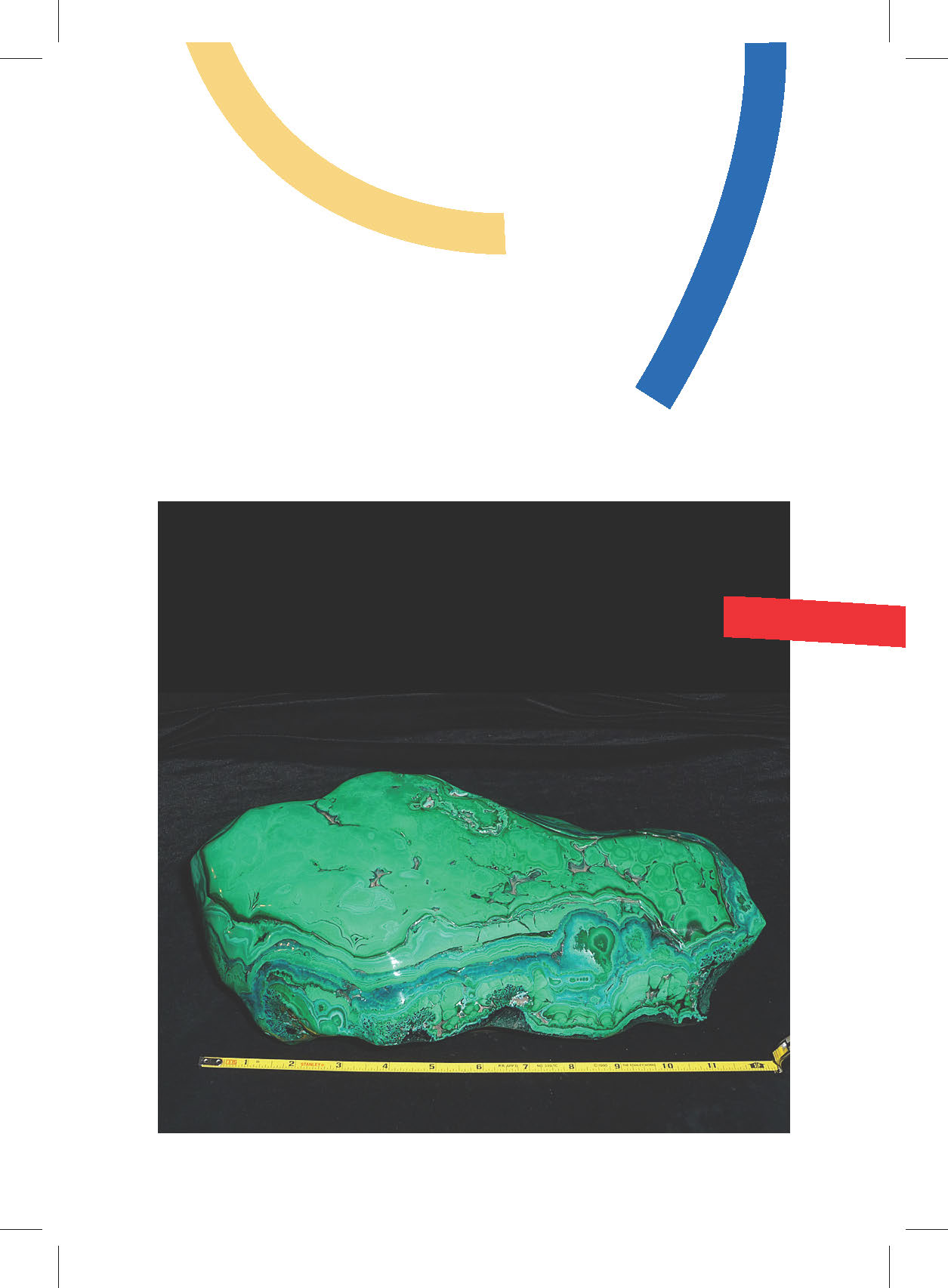
Sticks And Stones, 2015
Flyer
Lucy Skaer
Née en 1975 à Cambridge. Vit et travaille à New York et Glasgow.
Née en 1975 à Cambridge. Vit et travaille à New York et Glasgow.
Lucy Skaer
Née en 1975 à Cambridge. Vit et travaille à New York et Glasgow.
Née en 1975 à Cambridge. Vit et travaille à New York et Glasgow.
La Salle de bains reçoit le soutien du Ministère de la Culture DRAC Auvergne-Rhône-Alpes,
de la Région Auvergne-Rhône-Alpes et de la Ville de Lyon.
Sticks and Stones est un partenariat entre La Salle de bains, le British Council Scotland, le gouvernement écossais, le Musée Gallo-Romain de Lyon-Fourvière et le Grand Lyon - Métropole, les galeries Peter Freeman, inc. et Murray Guy.
de la Région Auvergne-Rhône-Alpes et de la Ville de Lyon.
Sticks and Stones est un partenariat entre La Salle de bains, le British Council Scotland, le gouvernement écossais, le Musée Gallo-Romain de Lyon-Fourvière et le Grand Lyon - Métropole, les galeries Peter Freeman, inc. et Murray Guy.
